ALENTEJO AND ALGARVE: CULINARY TRADITIONS OF THE SOUTH OF PORTUGAL
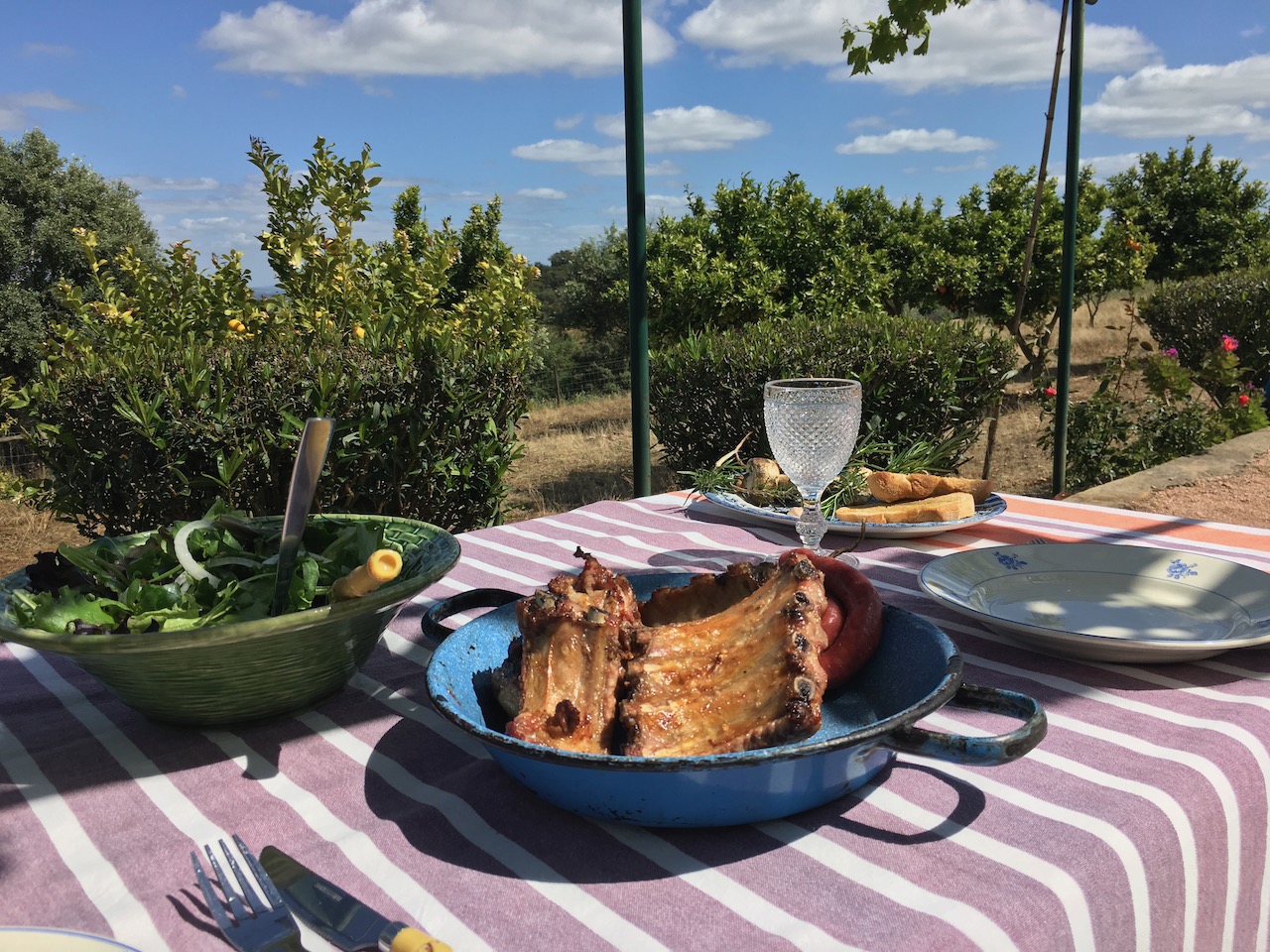
Condensing into one article the vastness of the cuisines from the Alentejo and the Algarve is no easy task, but we invite you to join our voyage as we explore one of the richest and most diverse of Portuguese regional cuisines, some of the most sought after wines and how, as we approach the very south of the country, we can almost feel the spiced scents of Northern Africa while sitting at the table.
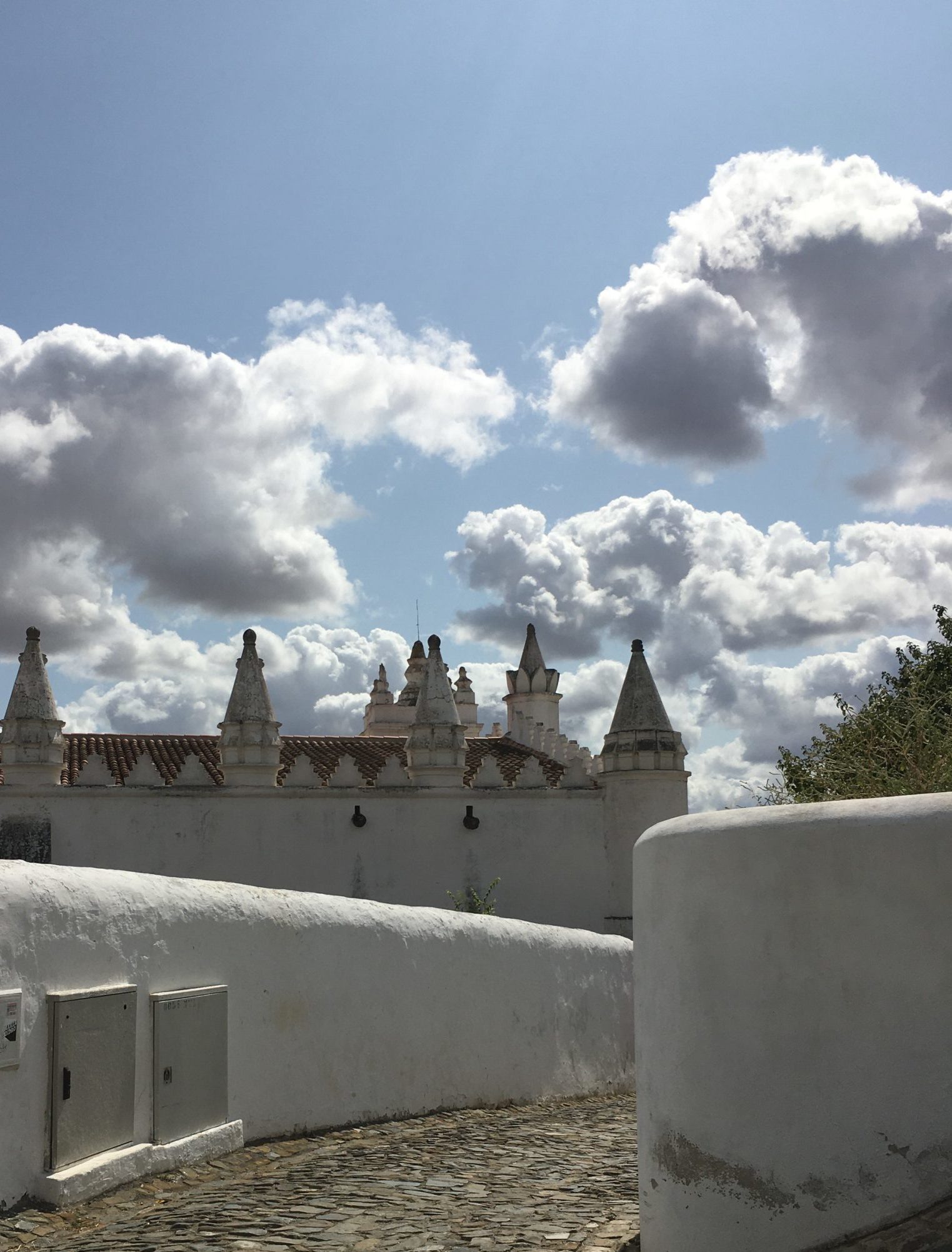
Arabic Mértola village
The presence of Romans and Arabs shaped the heritage of the Alentejo, where countryside landscapes present us with seemingly endless golden fields of wheat, olive groves, extensive vineyards, and forests of oak cork trees where Iberian pigs graze at their own leisure.
In the very south of the country, in the Algarve, you can feel the pulse of Mediterranean culture, which has over the ages been interlaced with Spanish and Arabic traditions and flavors.
The Alentejo: Portugal’s bread basket is also Portugal’s largest olive grove!
The basis of cozinha Alentejana
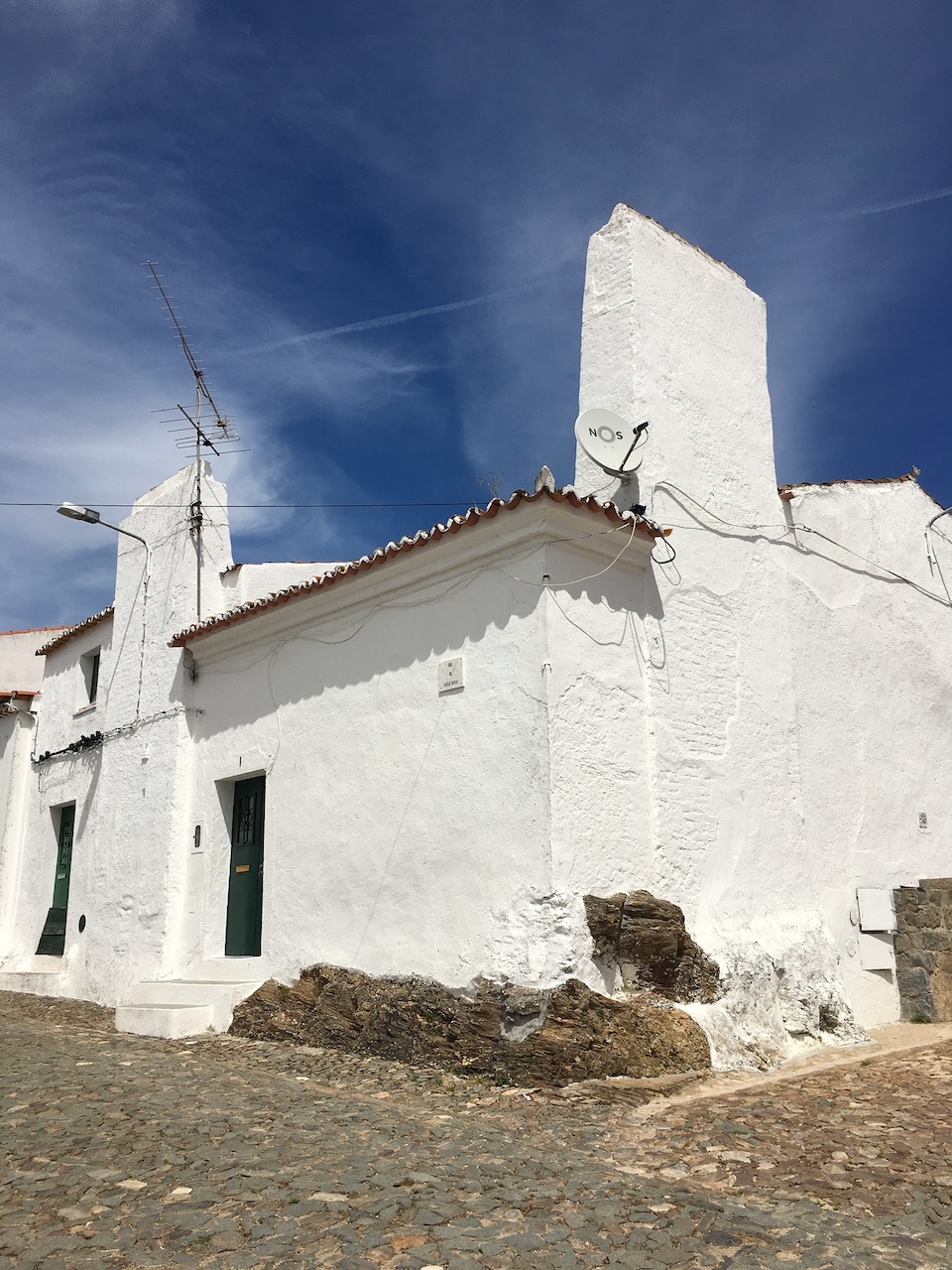
A humble and traditional house in Évora Monte
Geographically speaking, the Alentejo is the largest area of Portugal, and it is divided into the Upper Alentejo (with Évora as its capital) and the Lower Alentejo (where the main city is Beja). For the purpose of exploring Alentejo’s regional cuisine, this division is not of interest, but it may come in handy when you’re structuring your travel itinerary to make the most of your time in the area.
Arguably this could apply to Portugal as a whole, but this truly is a region where you can taste history and the influence of the peoples who have settled here over the centuries: the prevalence of free range pigs had its beginnings during the Roman Empire, and many of the dishes which are now some of the region’s most iconic recipes, are essentially connected with the Arabic influence from the Moors of northern Africa which came later on.
If we were to talk about the essential ingredients of cozinha Alentejana, which define the main flavors you’ll find in Alentejo regional cooking, we’d be speaking about things such as olive oil, garlic and coriander (which is a very frequent aromatic herb in Arabic cooking). The basis of Alentejo cuisine is rustic and humble, very much following similar principles as the cucina povera from Italy, which refers to the simple yet ingenious ways in which peasants would prepare ingredients, resulting in beautifully crafted dishes. In the Alentejo, high quality products, simplicity and sharp cooking skills come together to deliver lots of flavor!
The Alentejo is Portugal’s largest producer of olive oil, in Portuguese azeite, with over 400 producers responsible for making more than half a million liters of Portugal’s favorite oil for cooking and seasoning. Portugal encompasses 7 different olive oil production regions with protected denomination of origin (DOP, in Portuguese), and three of those are in the Alentejo: azeite DOP Moura, azeite DOP Alentejo Interior and azeite DOP norte Alentejano. The remaining Portuguese olive oil growing areas include DOP Ribatejo, DOP Beira Baixa, DOP Beira Alta and DOP Trás-os-Montes (Portugal’s second largest olive oil production area).
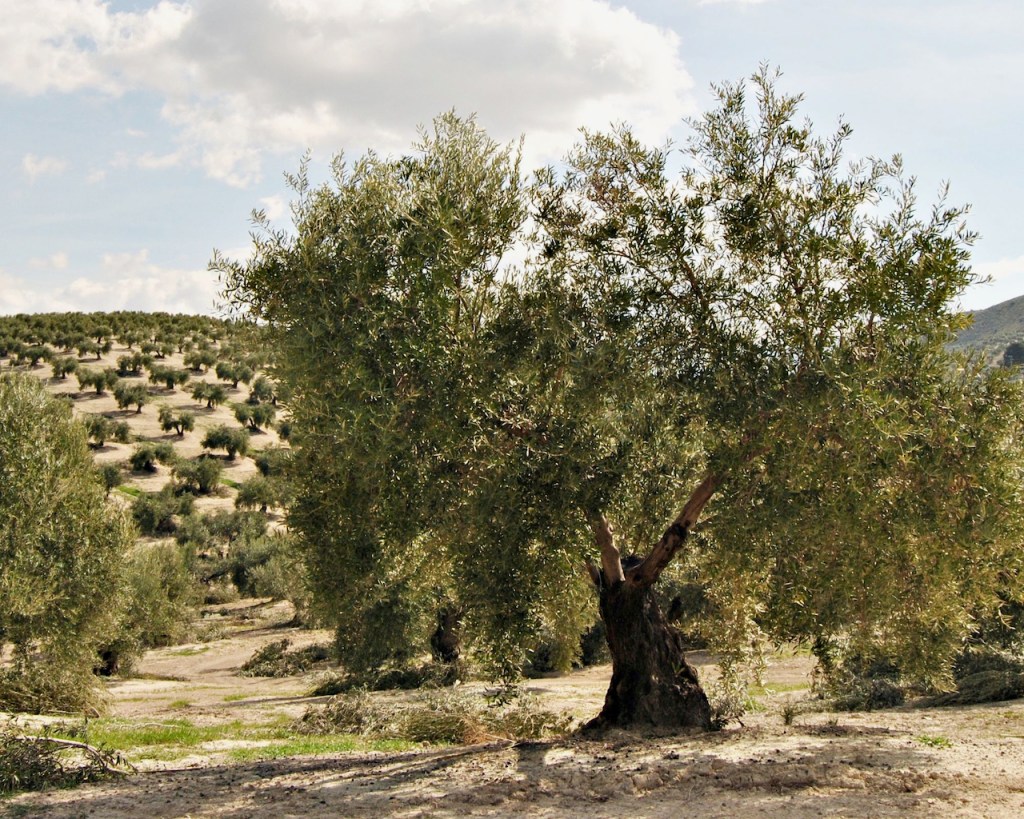
Olive trees in Baixo Alentejo, like in a scene from a Kiarostami movie
The pig as a religious differentiator
While writing about Alentejo’s regional cuisine it is mandatory to look into this region’s love affair with pigs. When the first king of Portugal, D. Afonso Henriques, took over Lisbon in 1147, he expelled the Moors from the city in order to start a Christian nation. But the Arabs from northern Africa didn’t leave Portugal overnight. They remained in areas of the city itself (such as the neighborhood of Mouraria)
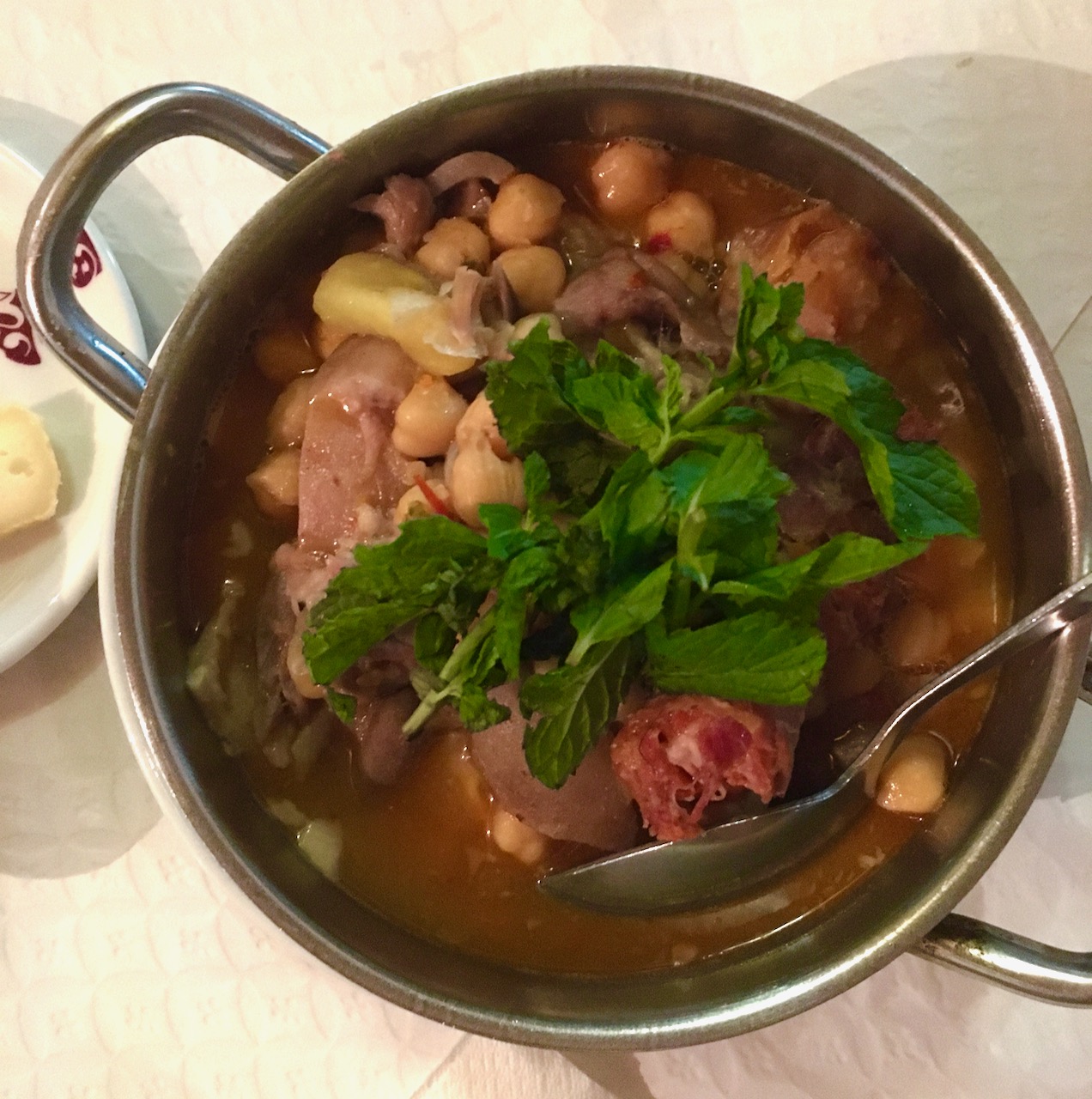
Chickpea stew (‘cozido de grão’) featuring several kinds of black pork cured meats (‘enchidos’) and black pork meat, at Café Restaurant Alentejo
and southern parts of the country, like the Alentejo and the Algarve. During the divisive years that happened next, local inhabitants made an effort to clearly showcase what religion they were following. Christians across the Alentejo not only kept pigs as sources of food, they made it a point to slaughter them in public, inviting friends and neighbors to this festival, and thus stressing their christian affiliations.
This would clearly set them apart from muslims and even jews which would consider pork haram or terefah, that is, forbidden by their religions. All across the Portuguese south, pigs became symbols not only of food and of a certain economic affluence, but of compliance with the mainstream religion.
As you drive today by the flat landscapes of most central Alentejo, you will come across enchanting oak tree forests which dominate much of the landscape. It is in the shades of these oaks that you’ll see free ranging black Iberian pigs, known in Portuguese as porco preto, which feed naturally on grass and acorns. These acorns were during the pre-wheat era pound and transformed into dense loaves of breads, a staple of the Portuguese medieval diet, but they are now consumed by black pigs which are slaughtered and transformed into some of the region’s most appreciated foods. Porco preto can be eaten fresh and grilled in dishes such as secretos de porto preto (Iberian pork belly), plumas de porco preto (low fat cuts of Iberian pork loin), or lagartos de porco preto (strips of meat cut from in between the ribs and the pig’s loin) – these are usually served with potato fries and salad. Iberian pork is popular because of its succulency and particular taste which occurs thanks to the wild diet of the pigs and their fat content, and this is why it is also customarily transformed into a very wide range of cured meats, known as enchidos de porco preto.
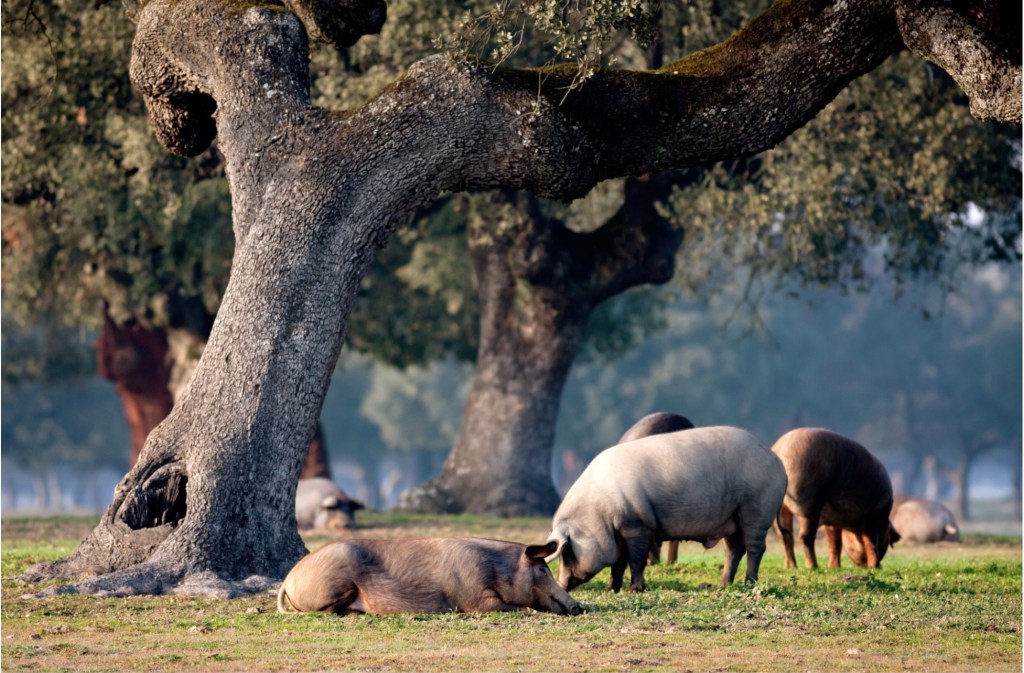
Free range black pigs under cork trees in the Alentejo region
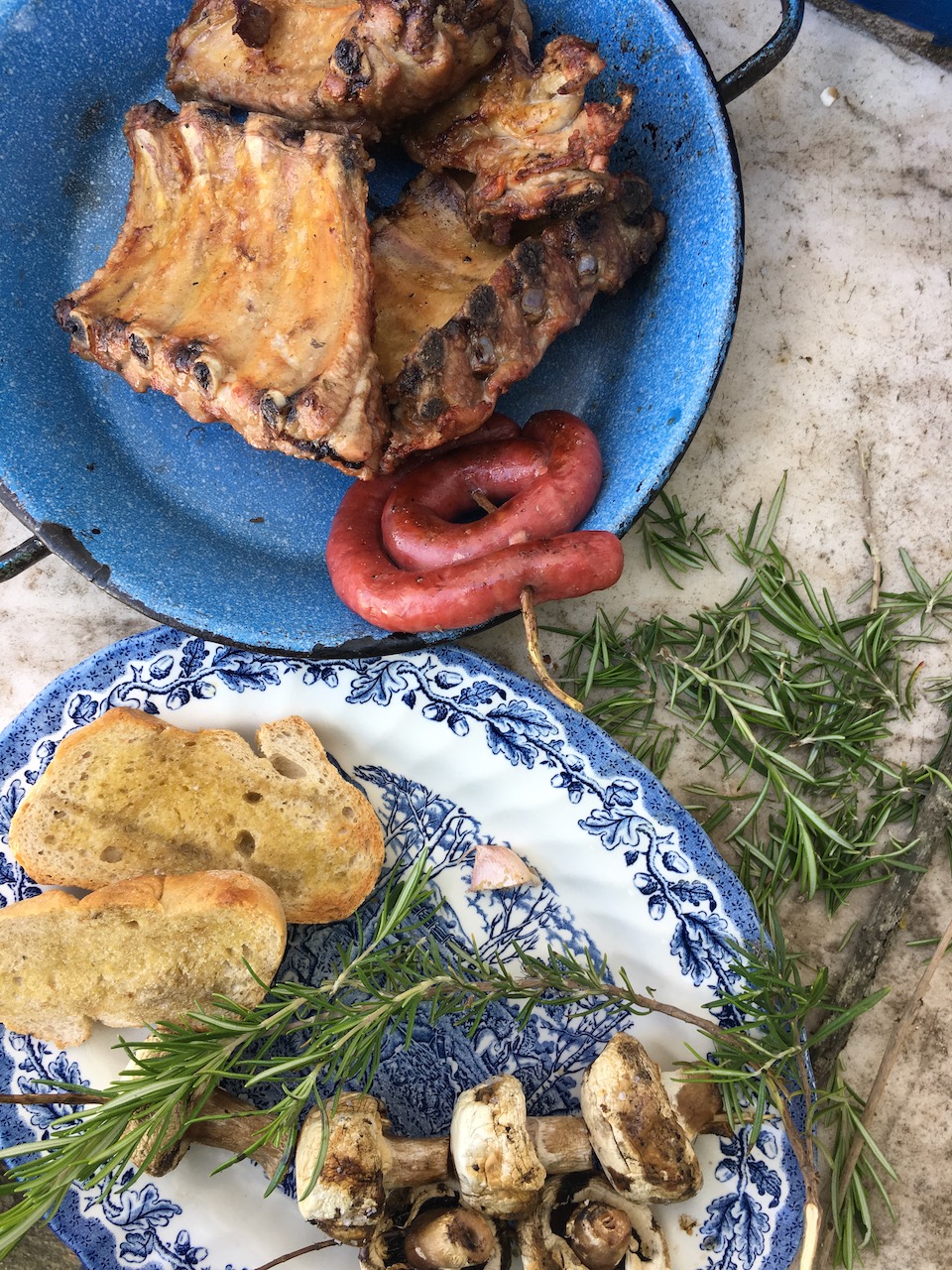
A simple homemade meal cooked while staying in a traditional ‘Monte Alentejano’ near Vila Viçosa village
Domestic pigs other than porco preto are also prevalent in the Alentejo, and are cooked in dishes like the extremely popular carne de porco à Alentejana, which is one of Portugal’s most famous dishes overall. Portugal’s surf & turf brings together paprika marinated pork chunks and clams cooked in pig’s lard, tossed along with fried cubed potatoes and a finishing touch of chopped fresh coriander (a common addition to many of Alentejo’s recipes). The town of Vendas Novas, in the district of Évora, is home to a sizable number of road-side restaurants specializing in bifanas, another pork based speciality. One of Portugal’s best-loved sandwiches, bifana consists of juicy pork steaks in a bun. While they are prepared all over Portugal (bifanas in Porto and Torres Novas are also very renowned!), Torres Novas has developed quite a reputation for this tender, white wine and garlic marinated pork sandwiches, which are a classic of Portuguese “fast food”… and even hangover munchies!
The importance of bread and water: an Arabic legacy
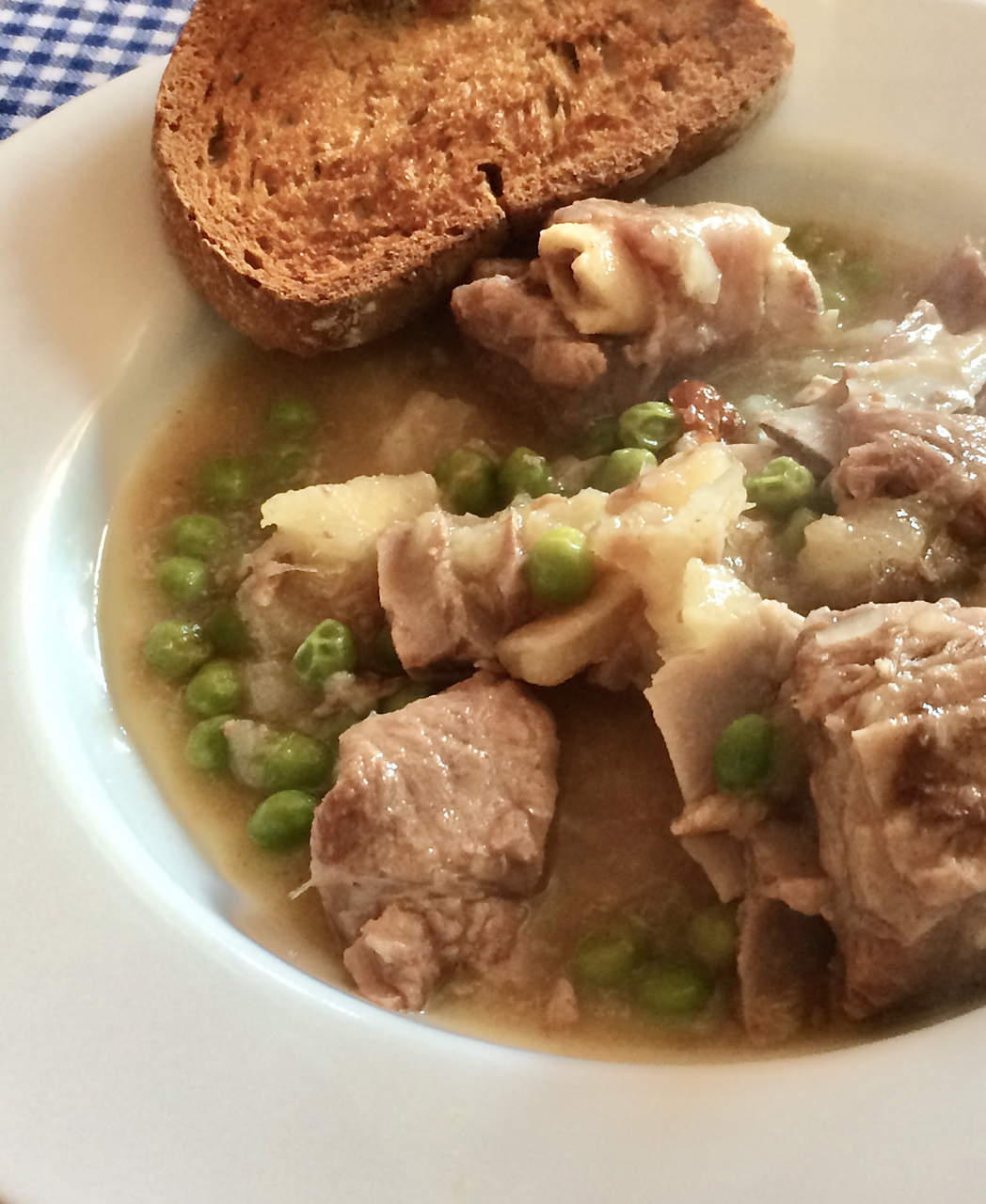
Homemade ‘ensopado de borrego’, inspired on a Chef Vitor Sobral recipe
The world of meats in the Alentejo is indeed dominated by pork, but it doesn’t stop here. Beef is also available and of the highest quality (look for Carnalentejana DOP to enjoy a local bovine breed known for its tender and flavorful meat), and so is lamb. The most sought-after lamb dish in the Alentejo is ensopado de borrego, which is a peasants’ dish by excellence, often cooked in rural areas. Ensopado with lamb consists of lamb condimented with spices such as paprika and bay leaf, stewed in white wine, and once again served atop slices of bread meant to soak up the meat juices.
If the Alentejo is familiarly referred to as “Portugal’s breadbasket”, we ought to start our exploration of the marvels of Alentejo’s cuisine speaking about pão Alentejano. A typical bread from the Alentejo weighs at least one kilo, and it is simply made with wheat flour, water, salt and natural yeast (traditionally saved up from the last batch of bread). Its characteristic flavor derives from the fact that it is cooked in a wood oven, which gives the loaves a crusty exterior while protecting the soft white crumb on the inside. Even though wheat is believed to have been first introduced by the Romans in the region, it was thanks to the Moors which popularized mills centuries later, that leavened breads such as this one became a daily staple. Without pão Alentejano, as we’re about to see, much of Alentejo’s regional cuisine wouldn’t be the same!
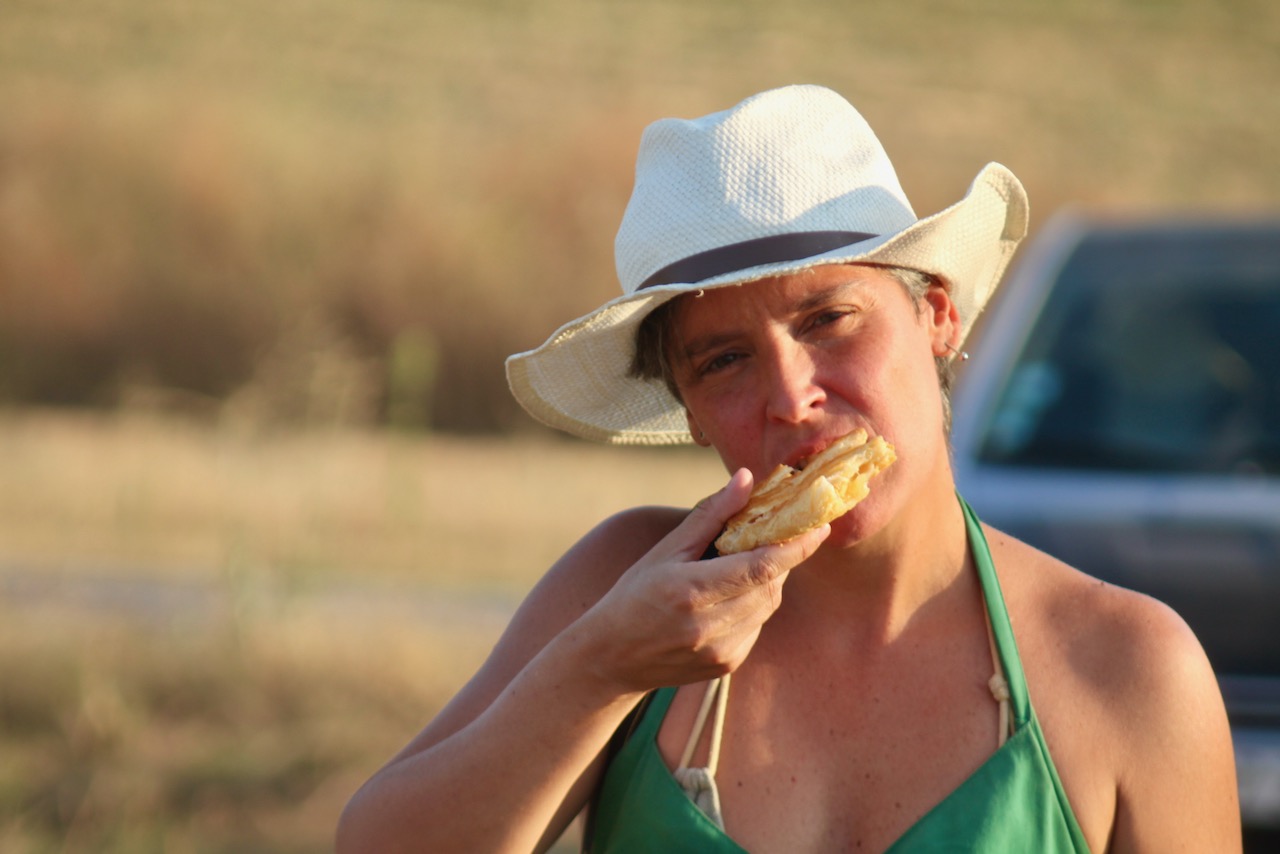
‘Tibornas’ can also be a travel snack everywhere!
Alentejo’s way of cooking is all about zero waste, particularly when it comes to stale bread. The region has come up with different recipes which make very good use of leftover bread which might have become hard. Tibornas, for instance, are a simple yet effective way of toasting bread and topping it with several ingredients, similar to torricados from Ribatejo or even bruschetta from Italy. Simple tibornas may feature from very simple toppings like olive oil and sugar, to more complete proteins like cured meats or salted cod. Stale bread is also used in hot dishes, such as açordas and migas. While in the rest of the country açorda stands for a bread porridge which can be topped with protein such as prawns and is served with egg yolk for added creaminess (and which derives from the Arabic word thurda, which literally means soaked bread), here in the Alentejo açorda stands for a soup prepared with a base of bread slices. Açorda Alentejana, as it is accurately known, is a simple yet flavorful stock prepared with olive oil, garlic and lots of coriander, which is poured over sliced pão Alentejano, and which can be completed with a poached egg or poached cod filet. On the other hand, migas or migas à Alentejana (to distinguish them from the migas you’ll find in the Beiras region, usually prepared with corn bread, beans and leafy greens), are a sort of large pan fried dumpling. Migas are prepared with crumbled bread, which is sauteed with fat and garlic. The most common servings of migas will be as a part of a dish called migas com entrecosto or migas com carne de porco, that is migas with ribs or chunks of pork. In this case the migas are papered with the fat dripped while cooking the meat, which adds a deeper layer of flavor. Vegetarians may want to order migas com espargos (migas with asparagus), but if you are picky you should probably check beforehand to ensure the dish was prepared with olive oil and not with pig’s lard.
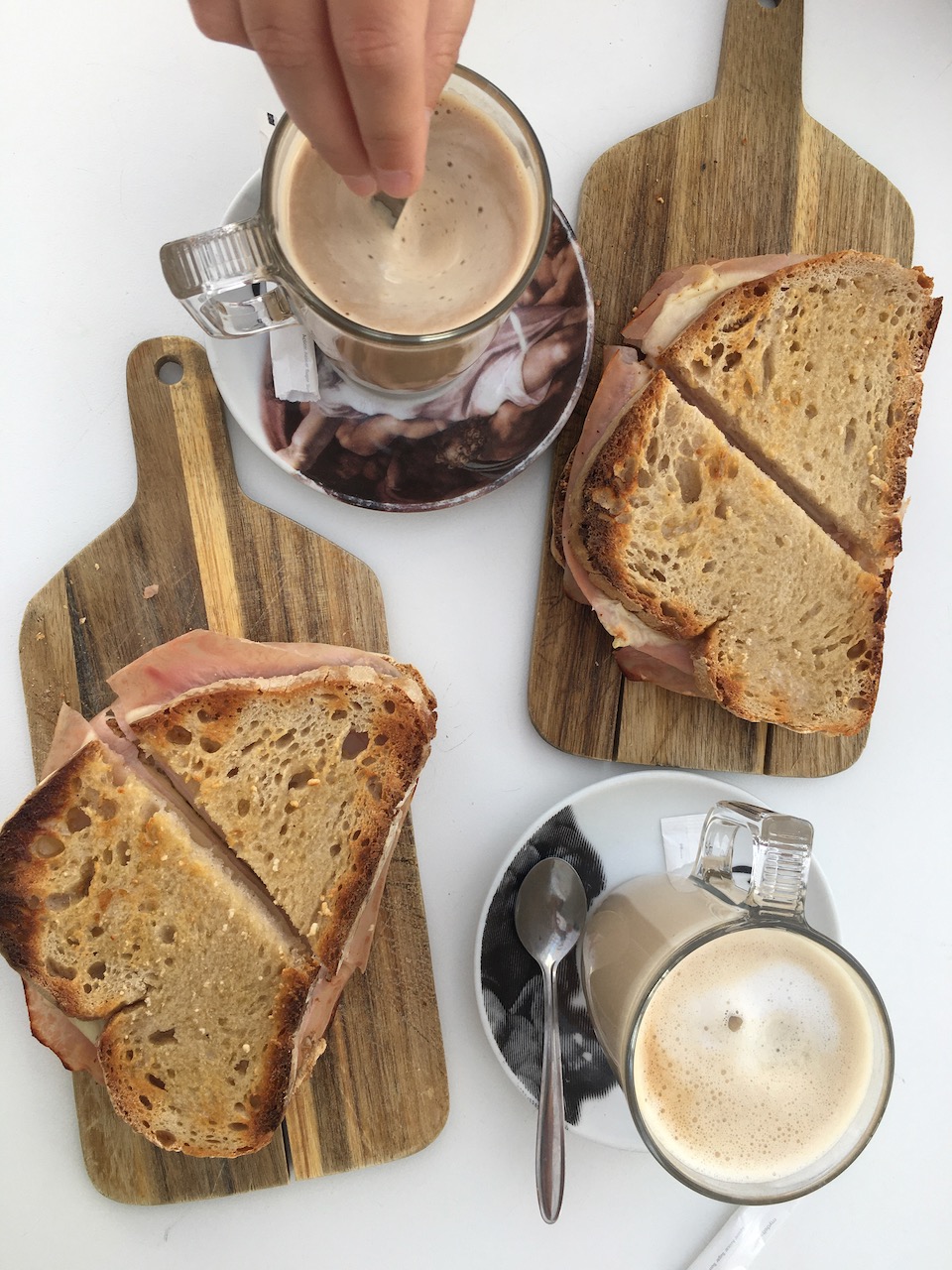
‘Pão Alentejano’ can also be tasted in a regular breakfast. This one, in Mértola village.
The Alentejano love for foraging takes us to sopa de beldroegas, a soup made with purslane which also grows spontaneously across the region during the Summer. Purslane soup features a simple garlic infused stock made with the greens, enriched with potatoes, eggs and pieces of cheese. There’s a popular saying in this region that goes like “in the Alentejo you can make soup with just about any herb”, and which speaks of the inventiveness of the Alentejanos which have lived through prosperous days as well as times of shortage, but always with great emphasis on inventiveness and flavor! Greens aside, another typical soup from the Alentejo is sopa de tomate, which is a tomato soup often eaten with chunks of bread and poached eggs – in that case it can be called sopa de tomate com ovos escalfados.
As the Alentejo is known for its incredibly hot summers (cue to silly jokes about the Alentejanos’, much like the stereotypical jokes Americans tend to crack about Mexicans), there are a few recipes treasured during warmer months. The most popular is probably gaspacho, which is a chilled soup which should not be mistaken with Spanish gazpacho. Gaspacho à Alentejana is also a cold soup prepared with tomatoes, cucumbers and hard bread but, unlike its Spanish counterpart, it is not blended. The vegetables are diced and covered with cold water, olive oil, vinegar and a handful of oregano. Gaspacho is easily one of the most refreshing meals you can have in the Alentejo.
Another fish speciality which is actually one of the most evocative dishes of the Alentejo is sopa de cação. This dogfish soup is prepared with the fish that is marinated in a vinegary concoction to soften its bones, to be then cooked with olive oil, garlic, paprika, bay leaf and lots of coriander, and served atop slices of regional wheat bread, just like it happens with many other Alentejano recipes.
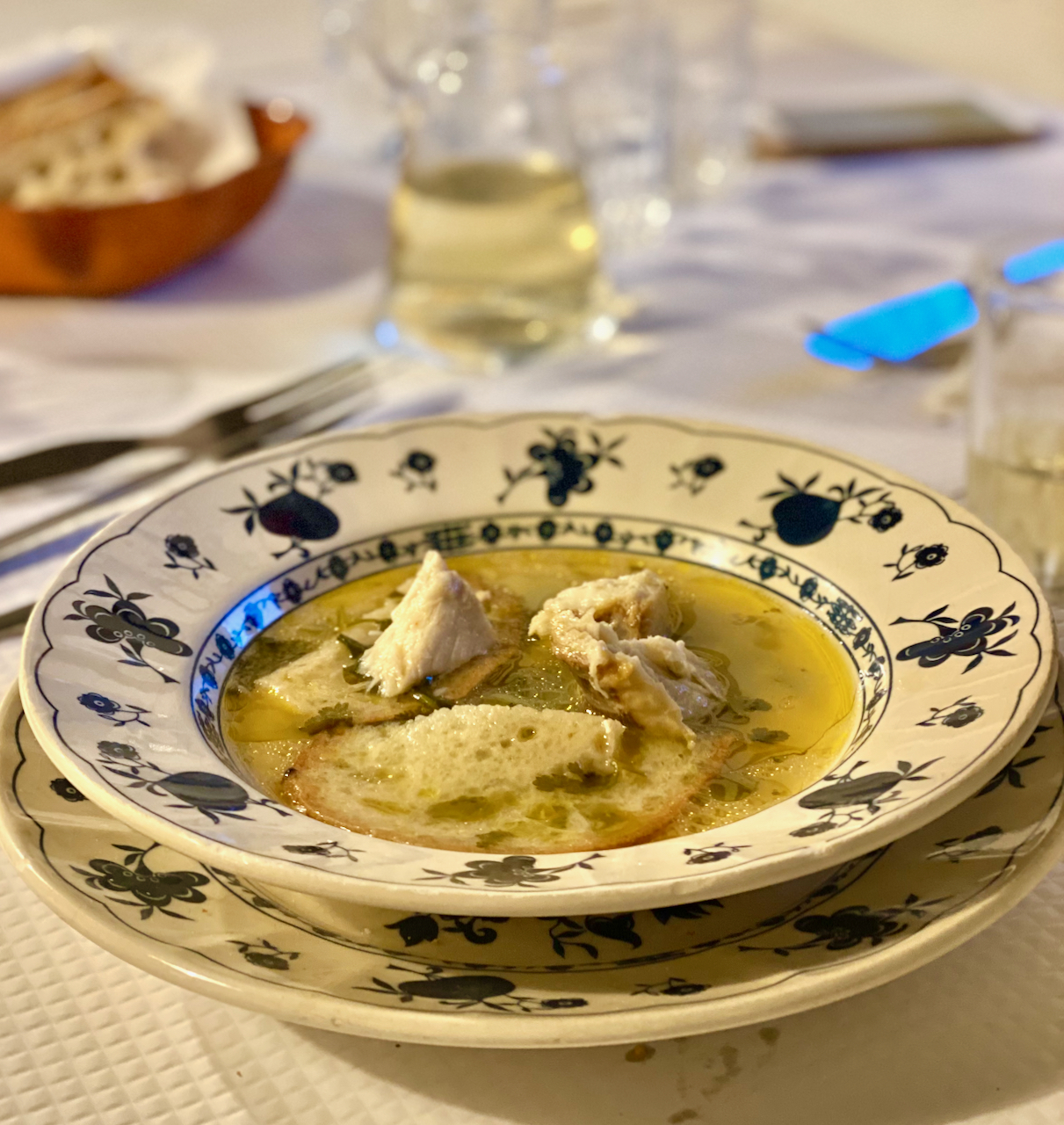
‘Sopa de cação’, in one of our favorite typical ‘tascas’ in Southern Portugal (see below)
The inception of sopa de cação is believed to go as far back as the 16th century, and even though this soup is all about dogfish, which comes from the Atlantic, the recipe is more closely associated with the humbler inhabitants from the interior of the Alentejo. Dogfish was regarded as a fish of lesser quality, and thus not preferred along the coast where other species were abundant. Not only was it cheaper, it also lasted fresh for longer, facilitating its transport to areas further from the coast, where it became a staple, mostly prepared in hearty soups which are nowadays beloved my many who would have back then looked down upon dogfish, which was seen by the Alentejo populations as a rather peculiar ingredient somewhere “between fish and meat”.
The coastline of the Alentejo
There’s no doubt that there’s an intersection between the coastal cuisines of the Alentejo and Portugal’s most southern Province, the Algarve (which we explore further down). So much so that the Southwest Alentejo and Vicentine Coast Natural Park, which stretches for about 100 km between Porto Covo and Burgau, precisely covers parts of both the Alentejo and the Algarve. Here you’ll find engaging trails along dramatic coastal cliffs, inviting beaches, picturesque fishing villages and, of course, plenty of marine life too!
When you’re into food, visiting towns with fishing traditions translates into enjoying delicious seafood meals. The Vicentine Coast is full of typical tascas, which are Portuguese taverns and small eateries which specialize in petiscos, such as fresh mollusks and crustaceans, as well as little plates of typical recipes like salada de polvo (octopus salad), salada de ovas (fish roe salad, usually prepared with hake roe), camarão ao alhinho (garlic prawns), salda de búzios (whelk salad), and many more. These tascas also tend to be the best places for fresh fish grills, peixe grelhado – as the charcoal grills are usually set outdoors, be fearless and let the heavenly smells guide you when you’re visiting a new town! Further local seafood specialities end up converging with dishes popular in other coastal areas of Portugal, and may include recipes like caldeirada made with fish or mixed seafood (similar to what happens to the north of this region, in Estremadura), feijoada de búzios (white beans and whelk stew) or arroz de tamboril (monkfish rice).
Local Alentejo cheeses and other petiscos
It’s interesting to note how folks from the Alentejo tend to be fairly active as foragers, particularly of wild asparagus (which are thin and fibrous and usually pop up between March and May), several varieties of mushrooms, and túbaras, which are a type of white truffles scientifically known as terfezia spp, or popularly also referred to as desert truffles. Do not mistake túbaras with túbaros, which is also a typical meal in the Alentejo, but in this case featuring testicles (most commonly of pigs, but can also be of ox or lamb) and certainly not truffles – but to each their own! Local cuisine sure uses pigs from head to tail, or should we say from ears to toes? Both salada de orelha (pig ear salad with a vinegary marinade) and pézinhos de coentrada (pork trotters and coriander salad) are typical petiscos in the Alentejo.

Manuel (with Boneca’s help) produces a fresh and pure goat cheese in Alentejo Interior
If the scorching temperatures of the Alentejo during summer months make you feel like going for a lighter meal, be happy to know that there are actually many options along these lines in the region. Besides the seafood petiscos mentioned above, you can also have small bites like tremoços
(lupin beans in brine, often served on the house when you order a beer, particularly in establishments with al fresco seating – not only in the Alentejo, but all over Portugal), azeitonas (olives, often marinated with garlic and oregano), empadas da galinha (individual chicken pies) or egg based dishes. In the Alentejo, scrambled eggs aren’t considered a breakfast food. They are a petisco best enjoyed with other ingredients in the mix, such as ovos com farinheira (scrambled eggs with farinheira pork sausage) and ovos com espargos (scrambled eggs with asparagus).
If everything else fails (but it won’t) you know no matter where you go in the Alentejo you can always ask for a charcuterie platter, which is a great way of exploring regional cured meat specialities which are eaten sliced and cold (unlike other Portuguese enchidos which are used to flavor stews) and which may include presunto (cured ham from the back legs of pigs), paleta (prepared in an identical way as presunto, but with the front legs of the animal), paio (smoked pork loin), and painho (similar to paio, but with more fat content), amongst many other variations of Portuguese sausages which differ from town to town. And wherever there is charcuterie, they shall be cheese too, and it just so happens that the Alentejo has magnificent regional cheeses, amongst which we could highlight at least those which have PDO status: queijo Nisa (soft cheese made with sheep milk), queijo Évora (also prepared with raw sheep milk, but sharper as compared to Nisa cheese) and queijo Serpa (cured sheep cheese, matured for at least one month in a moist environment).
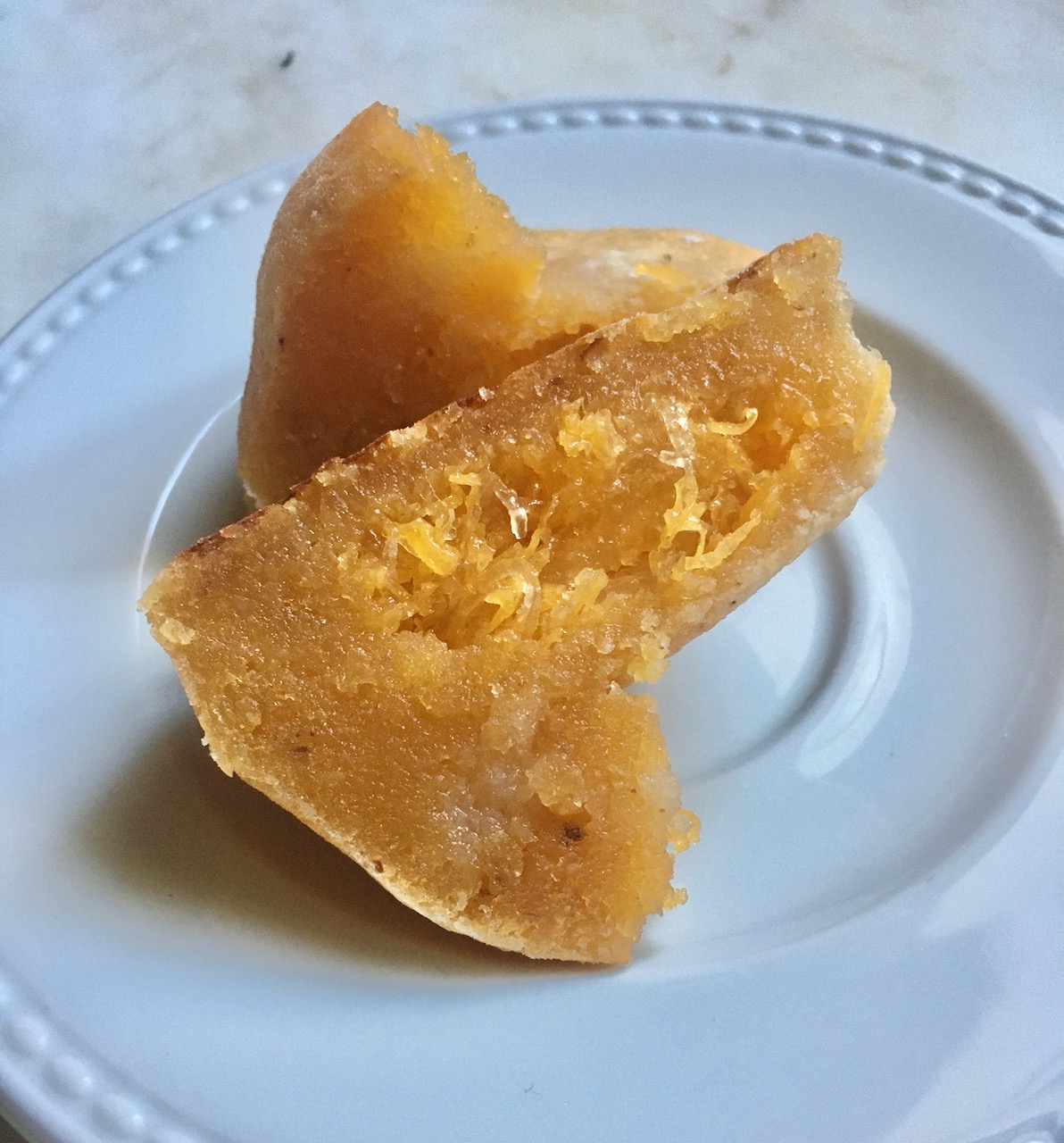
Mini ‘pão de rala’ from the amazing bakery in Estremoz
Fresh cheeses are also common in the Alentejo, if not as part of a cheese platter, more as an appetizer before a meal. The most common dairy products in the Alentejo similar to cottage cheese are queijo fresco (soft and fresh white cheese from cow dairy, ideal with a sprinkle of salt and pepper as it has a very mild taste on its own) and requeijão de Serpa (obtained when coagulating the milk for Serpa cheese).
Alentejo’s regional sweets
The repertoire of sweet dishes from the Alentejo would deserve a dedicated article of its own or, who knows, a trip itinerary which would explore the best regional desserts of the different Alentejo parishes. Sericaia is quite possibly Alentejo’s most famous dessert. Also known as sericá, this soft wrinkly cake is made with milk, eggs, sugar and cinnamon, and it’s prepared in a clay dish developed specifically for this sweet. It is usually served with preserved plums from Elvas (ameixas d’Elvas, which have PDO status and a dedicated museum in Elvas, which is along with Évora one of the two Alentejo cities which have been declared as World Heritage by UNESCO) and result in a very sweet and syrupy experience.
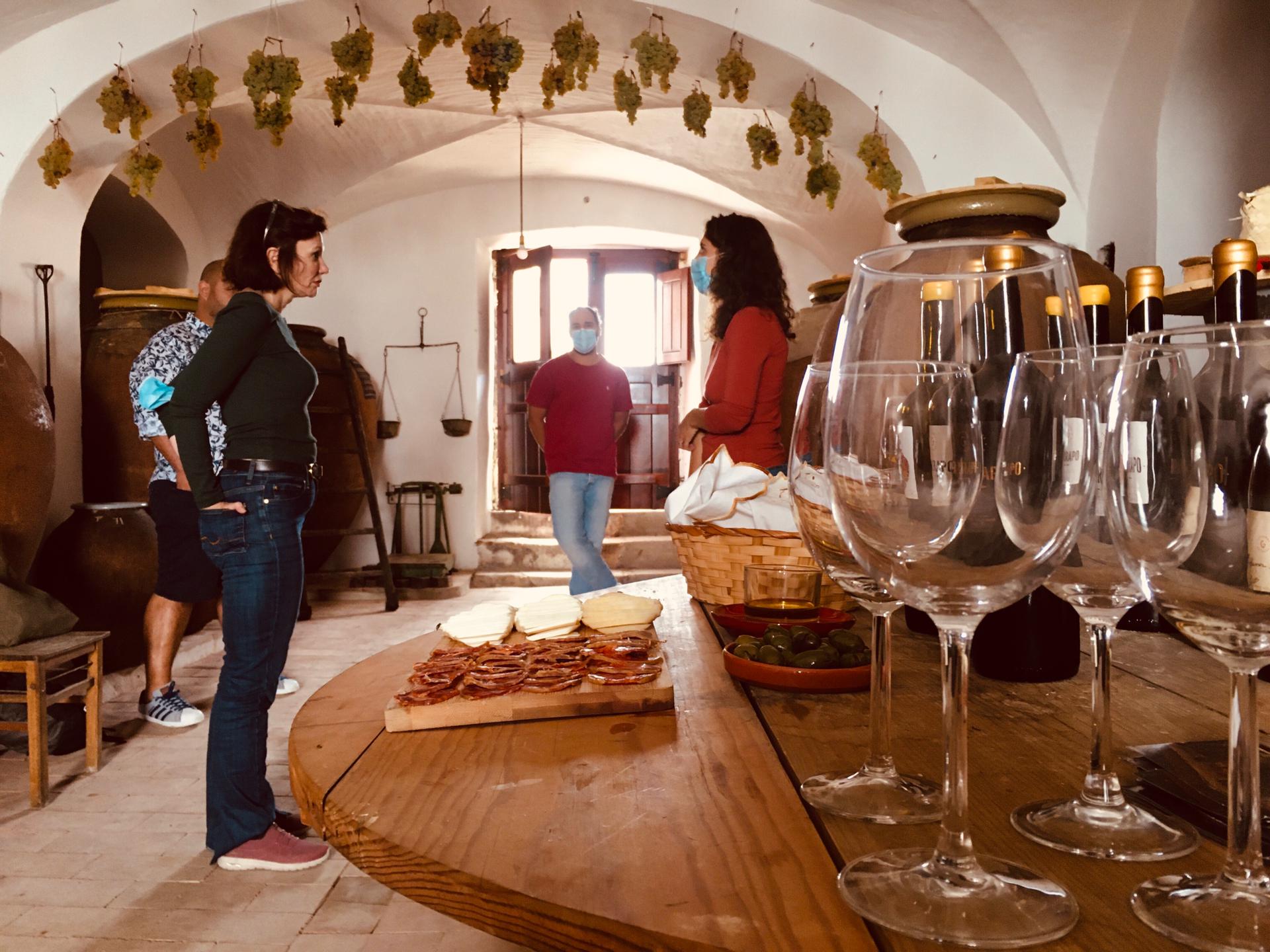
Oh! My Cod talha wine day trip during the traditional opening of ‘talhas’ in November
Other Alentejo regional sweets, more often than not belonging to Portugal’s “neverending” list of conventual sweets include pão de rala (syrupy egg threads, egg jam known in Portuguese as doce de ovos, and figleaf gourd jam wrapped inside a sugary almond meal crust, from Évora); encharcada Alentejana (a jam looking pudding prepared exclusively with eggs – mostly yolks – sugar and a touch of cinnamon); fidalgo (a layered eggs and sugar cake, with syrupy egg threads and “egg sheets”, which truly showcases the many creative uses of yolks and sugar the Portuguese have come up with over the years!); rebuçados de ovo (sugary egg yolks wrapped up just like commercial candy); and toucinho do céu (an egg rich wheat and almond flour cake traditionally made with lard, thus explaining the name “bacon from heaven”).
Wines from Roman times and other liqueurs
As you will certainly need good drinks to pair with the expansive list of dishes you will most likely feel like trying in the Alentejo, be rest assured that this is one of Portugal’s most prolific winegrowing regions. The Alentejo Wine Region (home of the vinho regional Alentejano) has been growing strong since the times of the Roman Empire, during which exports of wine used to travel from the Alentejo all the way to Rome! The Roman influence can still be felt at a small scale in the Alentejo, particularly when it comes to vinhos da talha, wines artisanally produced as per the ancient techniques, according to which the grapes are artisanally pressed and left to ferment inside clay amphorae with naturally occurring yeasts – undoubtedly one of the most unique wines you’ll get to taste in Portugal!
Other spirits which you will most likely come across in the Alentejo include licor de bolota (acorn liqueur), licor de poejo (pennyroyal liqueur) and the surprising gin by brand Sharish, slowly distilled in Reguengos de Monsaraz using local botanicals.
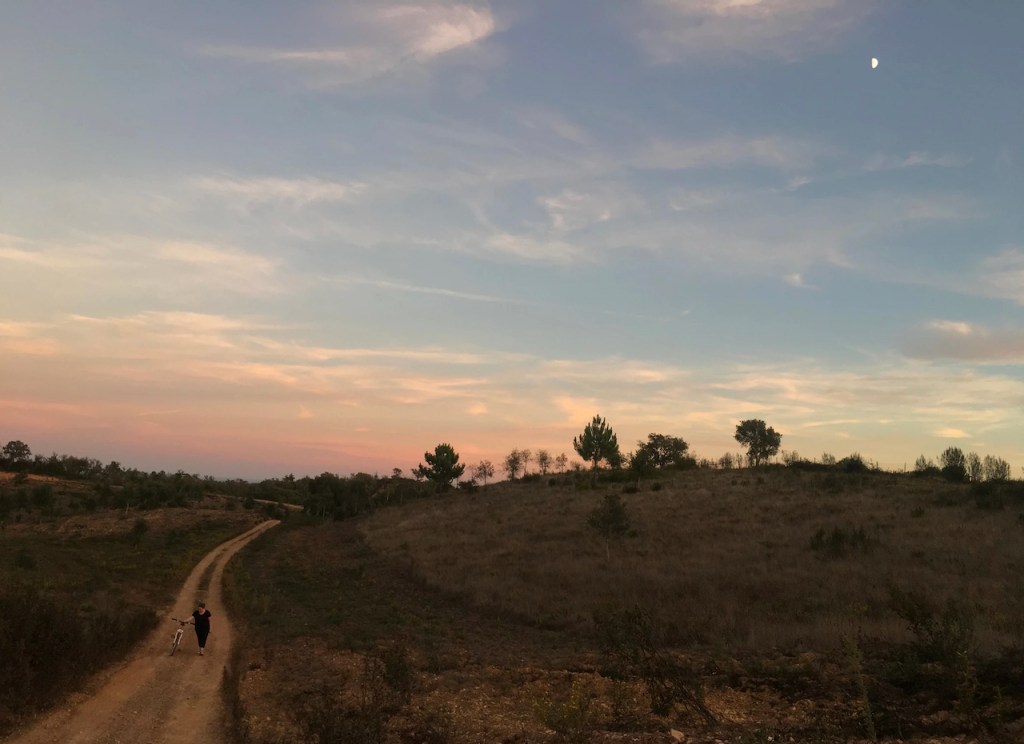
Alentejo Interior sunset landscape with Natacha Dias (aka @atlanticfisherwoman)
Algarve: where Portugal and northern Africa meet
Portuguese cuisine with Moorish and Mediterranean influences
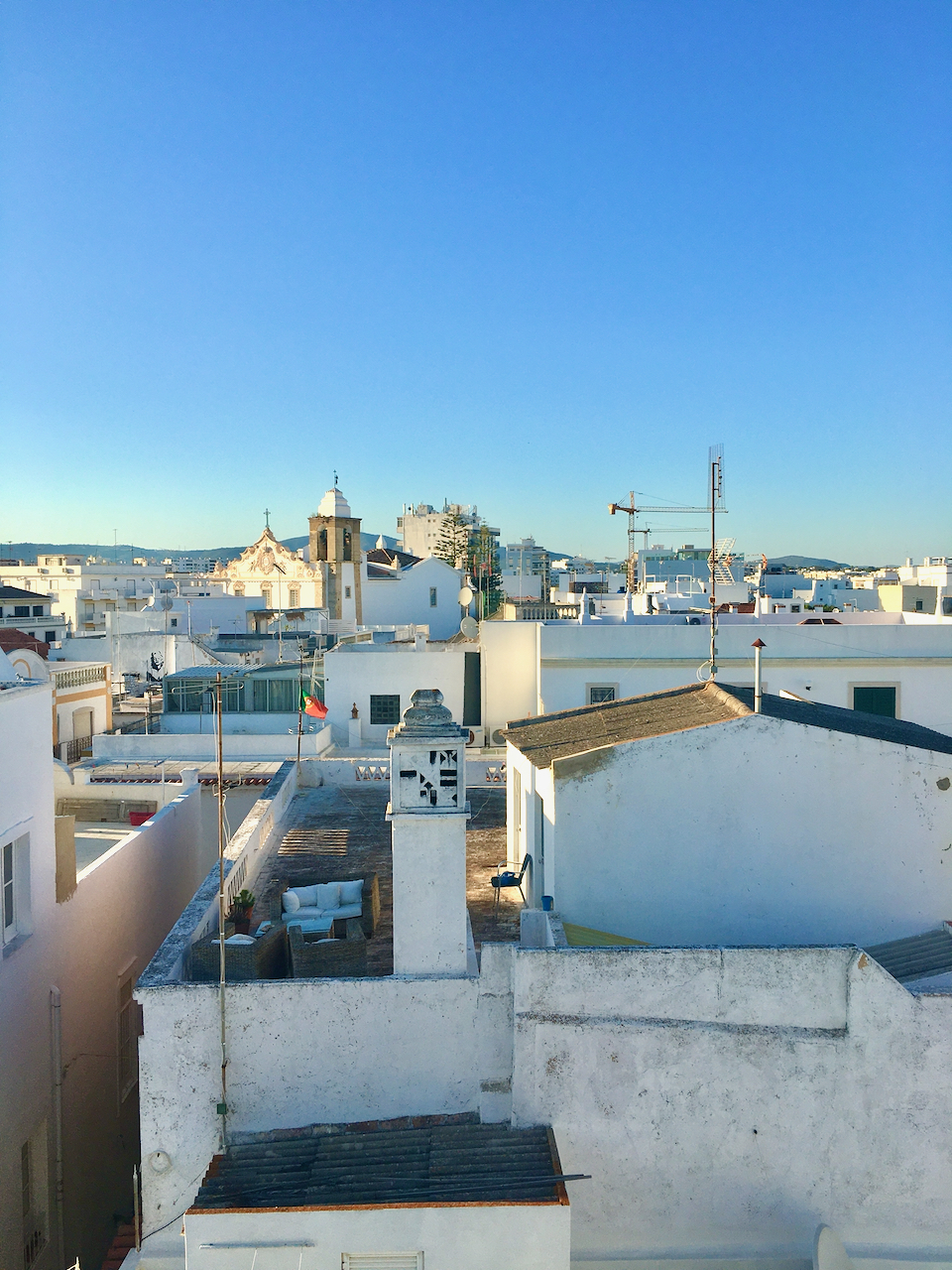
Rooftops in Olhão city, make us think we are in Marrakech or Fez.
The Algarve is the area where Portugal and Africa meet, and it is one of Portugal’s most visited regions by international tourists. But it is precisely because of the demands of pushing tourism, that genuine local food isn’t always that easy to come by. Of course there are tons of traditional and very Portuguese things to try all over the Algarve, but it helps to know what to look for and where.
If most folks come to the Algarve to spend time at the beach, we’d like to argue that there are other beautiful things worth visiting and doing in the region, and of course exploring the local cuisine is one of them!
The Algarve is the only region of Portugal whose coastline happens to be along the Mediterranean. Hence, this is where the Atlantic influences which are more notable across the Alentejo which we speak about above, and indeed all the way to the north of Portugal, until the border with Spanish Galicia, encounter the impact of the Mediterranean. This influence is notable in available ingredients and food habits, which have been shaped by the Mediterranean itself, as much as by the people who have inhabited the Algarve over the centuries.
Besides its popular coastline, the Algarve’s topography is also characterized by the presence of mountains, as well as an area between the mountains and the coastline, known in Portuguese as Barrocal. Being at the very bottom of Portugal’s map, with the mountains to the north, the Spanish border to the east, and water to the south and west, the Algarve is the most isolated region of Portugal. This geographical position, particularly before good roads were developed in more contemporary times, has made the communication between the Algarve and the rest of the country difficult, contributing to the Algarve’s very own local personality. As the people from the Algarve had a hard time exchanging goods and communicating with the rest of the Portuguese, they focused on their own local culture, cultura Algarvia, which is much more Mediterranean than elsewhere in Portugal, while remaining open to influences from further away, namely those from Northern Africa.
The Algarve’s inland mountains
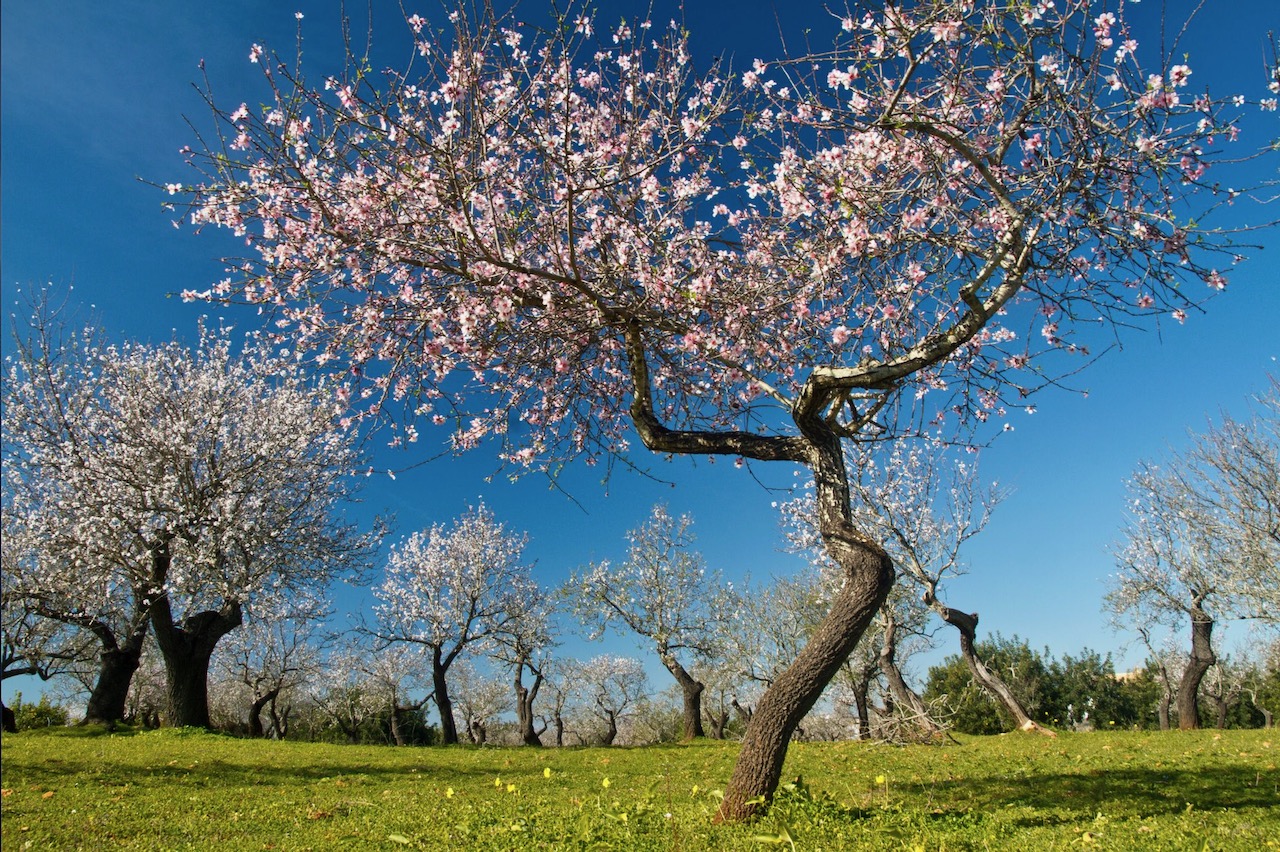
Almond trees along the Barrocal landscape, Algarve.
Before we reach the most popular parts of the Algarve which happen to be along the coast, let’s take a moment to explore the non-coastal areas of this region of Portugal: the Serra and the Barrocal. Both these areas have done a stupendous job at preserving their very own Algarvian identity and ways of life, and that is reflected in the local foods and typical dishes, prepared with both native and imported ingredients.
Serra do Caldeirão is a mountain range which literally divides the map between the Barrocal and the Algarve’s coastline, and the plains of Lower Alentejo to the north. While forests with trees such as a variety of oaks and strawberry-tree still abound in the serra, a substantial part of the land has been transformed to make it more favorable for agriculture. This is one of the areas where the Arabs back in the day first introduced foreign trees which are now a given in the Algarve, such as almond trees and orange trees.
Evergreen oaks naturally dominate the landscape of the Barrocal, but local inhabitants have over time planted other species which have meanwhile propagated in this area, including carob trees, almond trees, fig trees and citrus – which are all a clear inheritance from the Moorish occupation.
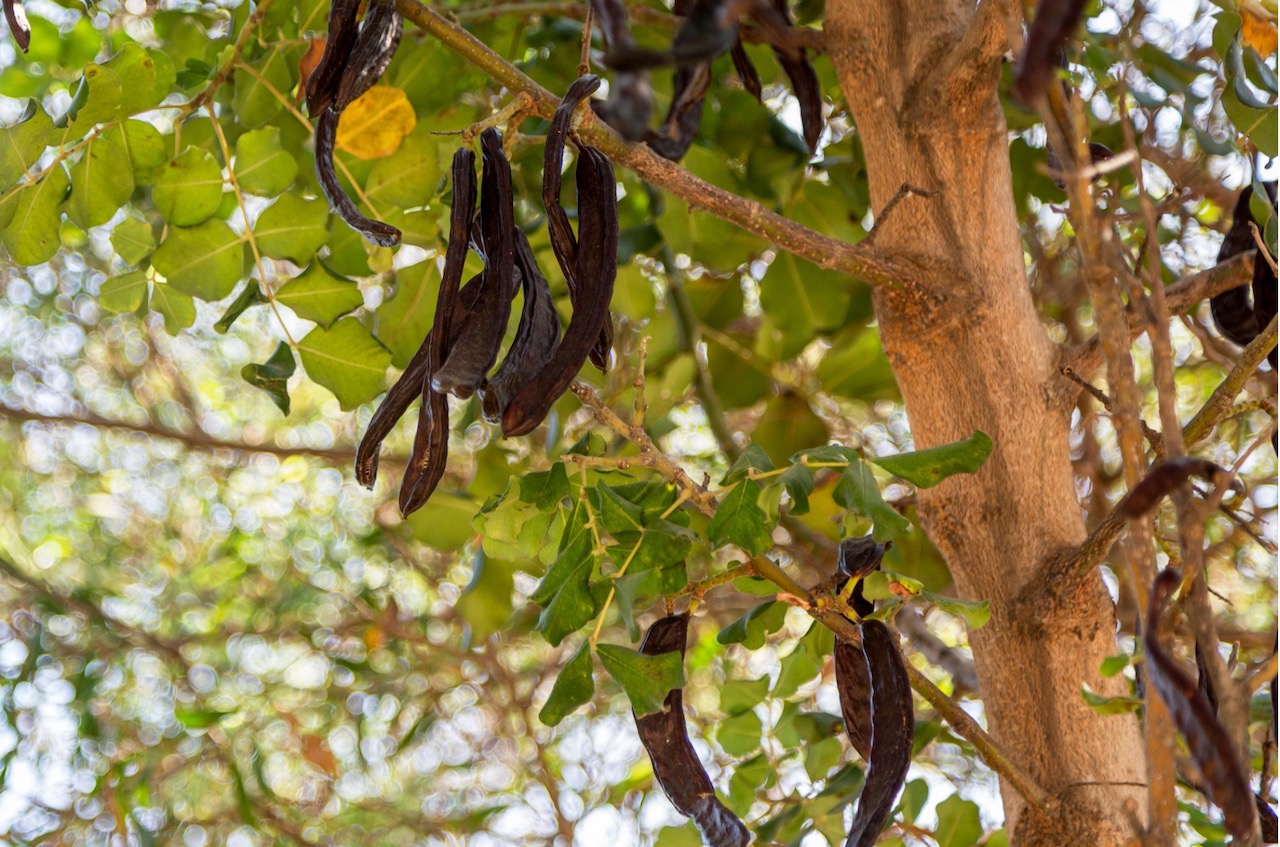
Carob tree.
The inlands of the Algarve were ever so often visited by nomadic merchants who’d bring over products from the coastline, namely fish and salt, which became a part of the local diet more than anything else that could have come from elsewhere in Portugal, namely from the Alentejo region which this area borders with.
Yet if something defines Algarve’s cuisine as we know it today, it is no doubt the coastline and everything that it allowed. The maritime ports of cites such as Sagres, Lagos, Portimão and Olhão, just to name a few, enabled the region’s contact with the rest of the Mediterranean world. This trade and cultural exchange affected the local lifestyle and, of course, the eating habits of Algarve’s inhabitants, both in the coastline and all the way to the mountains. Even in parts of the Algarve further away from the sea, the local diet made great use of all sorts of seafood including shellfish prepared in very specific ways, which we will explore next.
The Algarve’s maritime traditions

Olhão market
The ports and fish markets
Being a coastal region, the Algarve’s cuisine is strongly connected with the ocean. If you are into seafood, we’d highly recommend visiting the Algarve’s local fish markets, where not only you’ll be able to see from up close the
different species of fish that are most common in the Algarvian plate but, in some cases, also to appreciate the architecture. Strategically located within the urban centers, markets such as Mercado de Olhão (Av. 5 de Outubro, 8700-412 Olhão) and Mercado de Loulé (R. José Fernandes Guerreiro 34, 8100-535 Loulé) are a feast for the eyes and, even if you don’t care for the smell of fresh fish, you’ll be able to marvel at their neo-Arabic architectural traces. Other bustling fresh fish markets worth a stop in the Algarve include those in towns like Sagres, Lagos, Albufeira, Fuzeta, Tavira and Vila Real.
When you visit these markets, even more than when you eat at local restaurants, you’ll encounter an enormous variety of species that, let’s face it, don’t always make it to the menu of local eateries, but that are certainly a part of the local diet. If you’re staying at a rental with a kitchen, browse for something different and try to cook it yourself!

The seafood species which you’ll find in Algarve’s fresh fish markets cover those from higher deep waters, such as the north Atlantic, but also the Mediterranean sea and the African coastline. A few species to keep an eye out for include: tuna (atum), common pandora (bica), blackspot seabream (besugo), sardines (sardinhas), goby (alcaboz), John Dory (peixe-galo), rayfish (raia), European conger (safio), whiting-pout (faneca), Lusitanian toadfish (enxarroco or charroco), hake (pescada), Atlantic bonito (sarrajão), Atlantic mackerel (cavala), Atlantic wreckfish (cherne), gilt-head bream (dourada), alfonsino (imperador), flounder (linguado), turbot (pregado), European bass (robalo), swordfish (espadarte), monkfish (tamboril), spiny lobster (lagosta), European lobster (lavagante), scarlet shrimp (carabineiro), spider crab (santola), common crab (sapateira), donax clams (conquilhas), clams (amêijoas), razor clams (lingueirão), gooseneck barnacles (percebes), just to name a few!
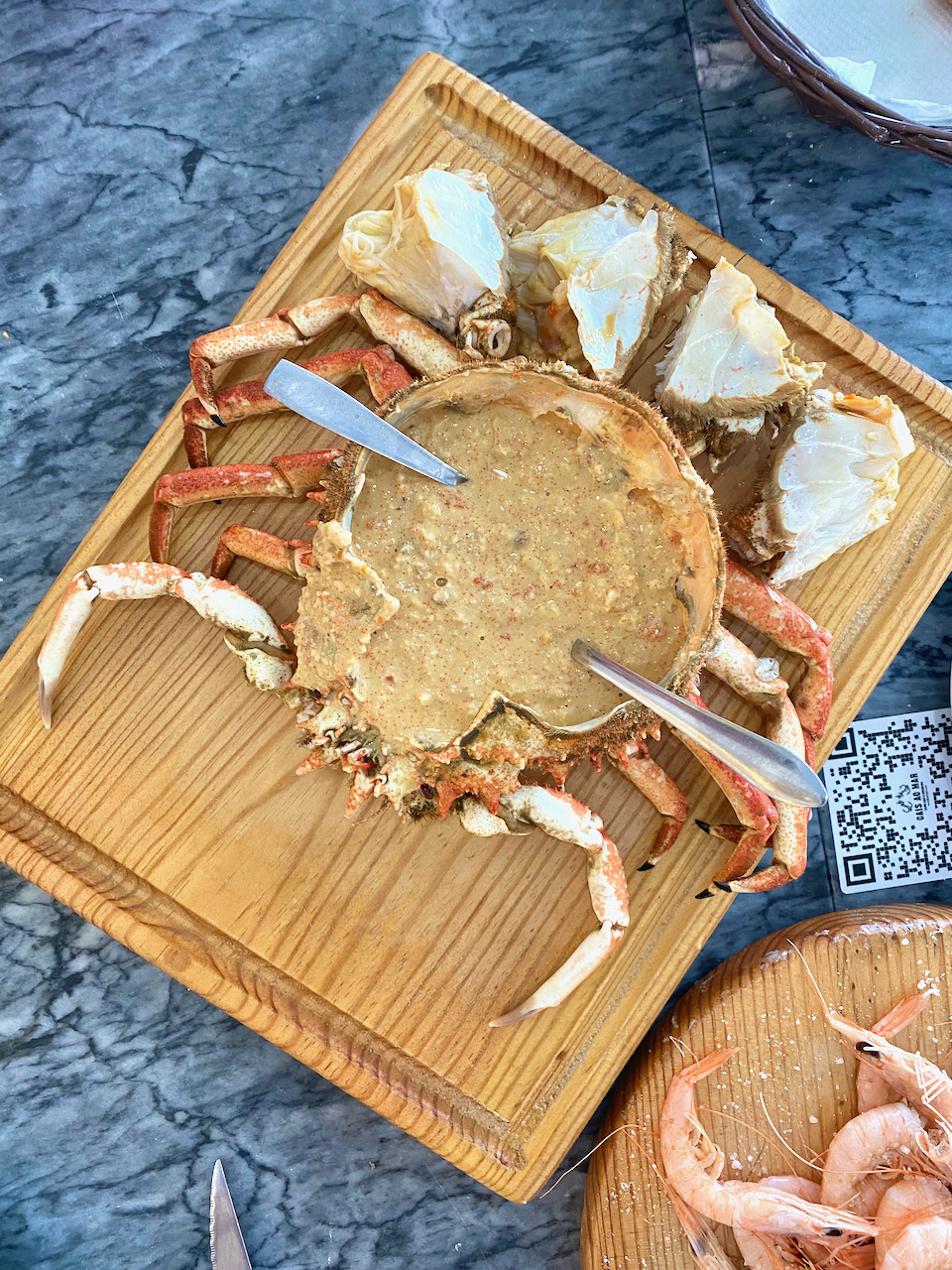
Spider crab in one of the best seafood Algarvian restaurants: Cais ao Mar
When it comes to actual restaurants in the Algarve, just like it happens in the Vicentine Coast we explore above, or like in the rest of the Portuguese seaside towns, of course you’ll easily find a variety of fish grills and other seafoods. But those particular to the Algarve also include oysters (ostras) and shrimp (camarão) from Ria Formosa, which is an area near Faro where the sea water and the river meet, providing an ideal environment for the development of these and a few other species.
Going a little more local, Lulas à Algarvia and choquinhos à Algarvia are typical dishes from the Algarve, featuring either squid or baby cuttlefish pan-fried in olive oil with garlic, and topped with chopped coriander. Algarvian food is all about simplicity in cooking, which allows for the actual taste of the freshest fish to shine through! Peixe alimado, an iconic Algarvian speciality, is yet another recipe meant to highlight the natural flavors of fish, without fully disguising them. It consists of fish, most commonly sardines or horse mackerel, which are salted for about 24 hours prior to boiling. Once cooked the skin of the fish is rubbed off and removed (this is called alimar in Portuguese, explaining the dishe’s name) and, when cooled, the flesh is marinated with olive oil, vinegar, garlic and lemon. Peixe alimado is eaten at room temperature, and can be topped with chopped cilantro, in good ‘ol southern Portugal style!
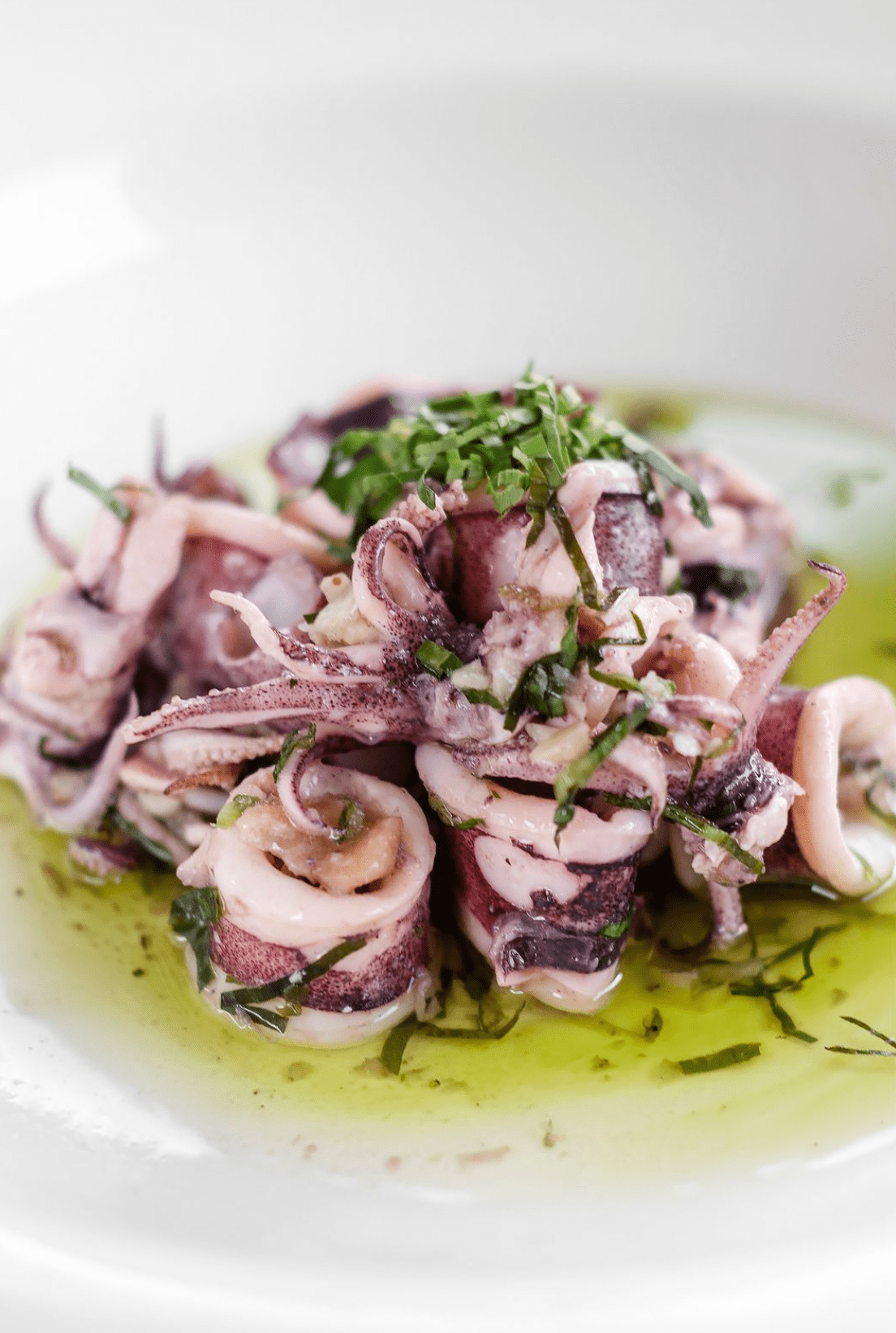
A dish of ‘lulas à Algarvia’
Octopus is also very appreciated in the Algarve, such as in the roasted octopus drenched with olive oil dish polvo à lagareiro. Tavira, and more specifically the village of Santa Luzia which belongs to this municipality, is considered the “Portuguese capital of octopus”. At some point during the 20th century, most families in this town made a living catching octopus, a trade which was handed down from father to son at a young age. Even though now-a-days octopus fishing doesn’t have the impact in the local economy which it once had, you can still visit the village of Santa Luzia for an incredible octopus meal, caught the traditional way: fisherman put clay pots (known in Portuguese as alcatruz) inside the water, which octopi climb into to nibble on the shrimp placed there as bait, and which are captured once the pots are taken out of the water while the octopi are still inside.
Even though you’ll find octopus dishes in many parts of the country, it is only in this area of Portugal where you’ll often come across octopus (and other seafood) served with sweet potatoes. The Algarvian town of Aljezur produces batata doce with protected geographical indication status, having even dedicated a museum to sweet potatoes, as well as an annual food fest which celebrates this tuber.
Just after the Azores, the Algarve is the second biggest consumer of tuna in Portugal, which is enjoyed grilled as bifes de atum.
The Algarve’s salted and dried fish
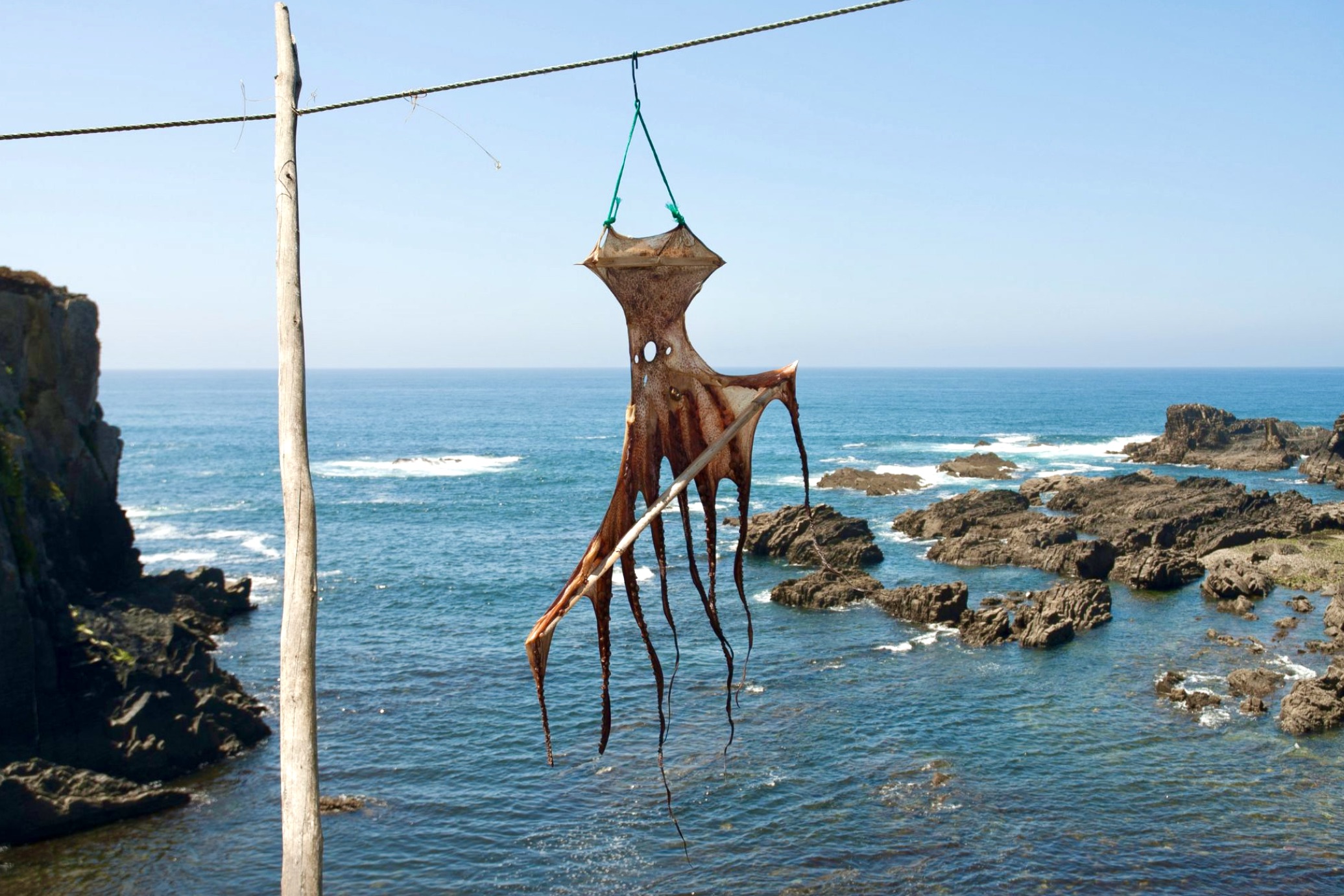
Octopus being dried under the sun, in the Algarve region
There’s archeological evidence to support the fact that fish preservation has an ancient history in the Algarve. Tuna, for example, can be dried and preserved into a kind of tuna charcuterie. Muxama is to tuna what presunto is to pork: it consists of dry and salted tuna loin, eaten very thinly sliced. Estupeta de atum follows a similar production method as muxama, but it’s prepared with pieces of tuna (which may include parts considered less noble such as muscles, head and fins) instead of with an entire tuna loin. The production of muxama and estupeta goes back many centuries, when fishing techniques and boats’ poor resistance prevented fishermen from heading out into the water on days when the ocean was rougher. The origins of fish drying in the Algarve are believed to go as far back as the presence of the Phoenicians in the area, that is around the 6th century BC. Yet there is no doubt that fish salting was perfected by the Romans, the masters of fish preservation in the Iberian Peninsula, about half a millennia later. Of course salting fish in the Algarve, back then and today, is only possible because of the region’s production of salt, sal marinho, which amounts to 95% of all the sea salt collected in Portugal.
Besides tuna, one of the other species typically dried according to ancient traditions is octopus, known in portuguese as polvo seco. You’ll come across dry octopus in traditional festivities in the Algarve, where this delicacy is roasted over charcoal. The octopus is caught following the clay pot method we mention above, or using covos, that is boxes of hard net which also welcome and imprison the mollusk. Afterwards, the octopus is washed and gutted, hit vigorously and placed in brine to help soften the flesh, and finally hung on ropes for 4 to 5 days to dry naturally between sun and shade. Eating polvo seco in the Algarve is like tasting history and the know-how that has been passed on over generations and even cultures in this region for many centuries!
Arabic influences on Algarvian food
Besides salt cured fish, other typical seafood recipes from the Algarve take us back to the days of the Moorish occupation. The Arabic influence can be felt in dishes like cataplana and xerém.
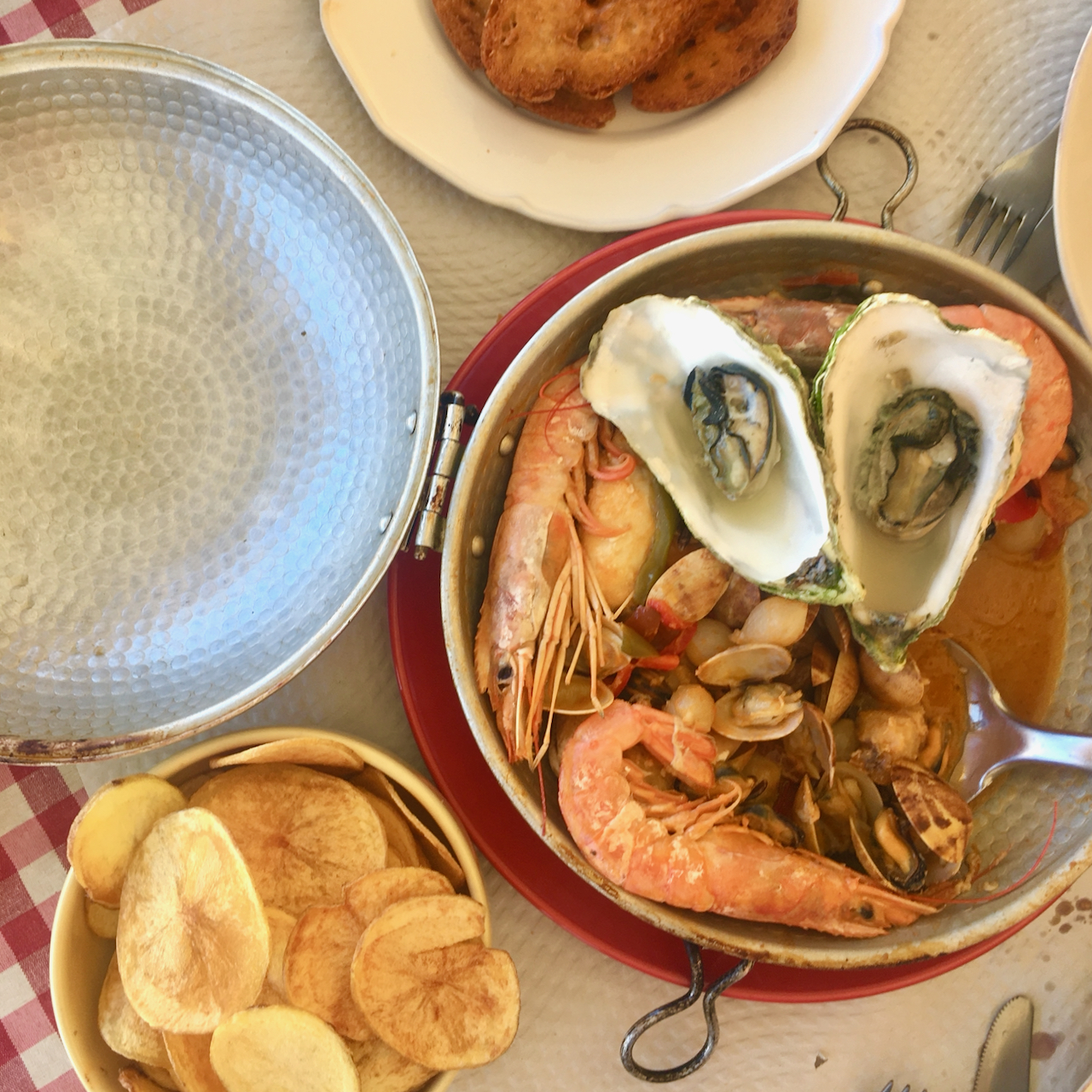
‘Cataplana’ in a restaurant owned by two sisters, on the Culatra island
Cataplana is technically the name of a clam shaped cooking vessel, which is traditionally made with copper but that can still remind us of a tagine, cooking technique shape-wise, and it is used to steam a variety of ingredients locked inside this pan which prevents flavors from escaping, thus concentrating a lot of taste but also nutrients. Dishes prepared inside this type of pan are also called cataplanas, and some of the most famous include cataplana de peixe (with mixed fish, potatoes and vegetables), cataplana de marisco (with a variety of seafood), or cataplana de porco com amêijoas (reminiscent of carne de porco à Alentejana, with pork chunks and clams, minus the typical paprika marinade from the Alentejo). This is an explicit example of how land and sea come together in Algarve’s cuisine, speaking of the connection between the serra, the Barrocal and the coastline.
Xerém or papas is widely regarded as a dish which the Portuguese exported to ex-colonies such as Brazil and Cape Verde, but its true origins are in northern Africa, and it was brought over after the 7th century. It consists of a savory corn porridge, also known as xarém, which is particularly popular around the city of Olhão, and which can feature a variety of accompanying seafood, including xarém de conquilhas (with cockles) and xerém com amêijoas (with clams), which festively and funnily enough is called baile de roda com castanholas around Olhão, that is, circle dancing with castanets! You will find xerém all over the Algarve, no matter if along the coast or the islands, as it is an extremely versatile dish which can be prepared with whatever ingredients you have in hand, fish, meat or vegetables, and is well-liked by folks from all social and economic backgrounds.
Escabeche, while not a dish per se, is a preservation technique and enhancement procedure which we can also link to the Arabic presence in the Algarve and the rest of the Iberian Peninsula, during the age of al-Andalus. Escabeche is usually applied to small fried fish such as sardines and horse mackerel, but it can potentially be used with any other fish. It comprises marinating the fish with vinegar, which changes its flavor and texture, but also makes it last longer. Escabeche fish is most commonly eaten cold as an appetizer, and even though it initially came about as a preservation technique, before the days of refrigeration, it is now prepared for its unique taste. To further go into how cultures and gastronomies are linked a little all over the world, according to each region’s history, it’s interesting to note how the Portuguese got escabeche from the Arabs and, many centuries later, took this cooking technique to Japan, where now-a-days you can still find nanbanzuke, aka Japanese escabeche. Certain currents of thought believe that escabeche is also linked to ceviche, with the Spanish would have influenced when reaching the Americas.
Algarve’s vegetarian dishes
Besides xerém with vegetables, other traditional naturally vegetarian dishes in the Algarve include a renowned carrot salad and eggs poached in a rich tomato sauce.
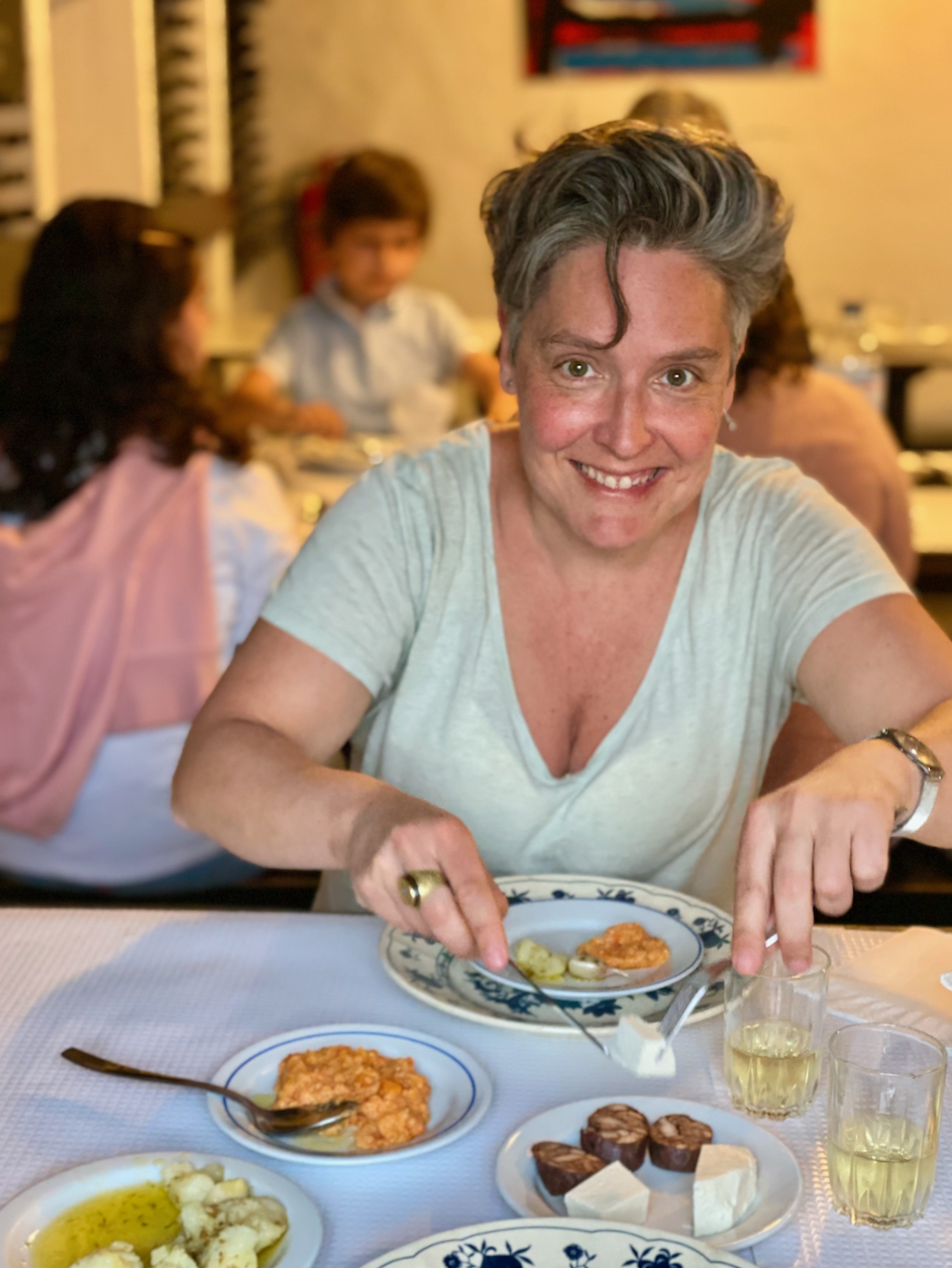
The best ‘tomatada’ I had was at this very peculiar restaurant in Mexilhoeira Grande.
Salada de cenoura à Algarvia, or carrot salad Algarve style, is a very simple yet very suggestive dish which anyone from Portugal would immediately associate with the southernmost region of Portugal. It consists of sliced carrots boiled until slightly soft, served cold in a marinade of olive oil, vinegar and garlic. Algarve’s chilled carrot salad is a great appetizer for a local meal!
For something more filling, ask for tomatada Algarvia, or simply tomatada, also prevalent across the Alentejo. This dish, which can also be listed in a restaurant’s menu as ovos com tomate à Algarvia, will remind those acquainted with Middle Eastern cuisines to shakshuka or even Turkish menemen. Once again, this is the embodiment of the simplicity of Algarvian cuisine at its best, showcasing poached eggs with creamy yolks, cooked in a nestle of rich tomatoes stewed with onions and garlic in olive oil.
Algarvian meat
Apart from pork, if you are into meat more than you are into seafood, there are a few other dishes you can look for in the Algarve, namely javali assado (roasted wild boar, usually from Serra do Caldeirão, the mountain range which reminds us that there’s more than beaches in the Algarve) and frango da guia (the local take on chicken barbeque, which normally features small chicken with very tender meat, typical from Guia in Albufeira).
Barrocal and the non-irrigated trees
One of the specificities of the Algarve region is the presence of non-irrigated trees creating a landscape of figs, almond, carob and olive trees, intermingled with citrus fruits.
Figos do Algarve, that is, figs from the Algarve, are actually sun-dried figs which usually have a thin skin and fairly sirupy irresistible flesh on the inside. Figs trees are originally from the region now-a-days known as Afghanistan, and were brought to the Mediterranean by the Arabs, which started the tradition of smashing the fruit into a flatter product to be dried and thus preserved. Figs were and still are an essential part of the Algarvian diet, and feature in jams as well as in typical cakes from the repertoire of doçaria algarvia, which we explore further below.
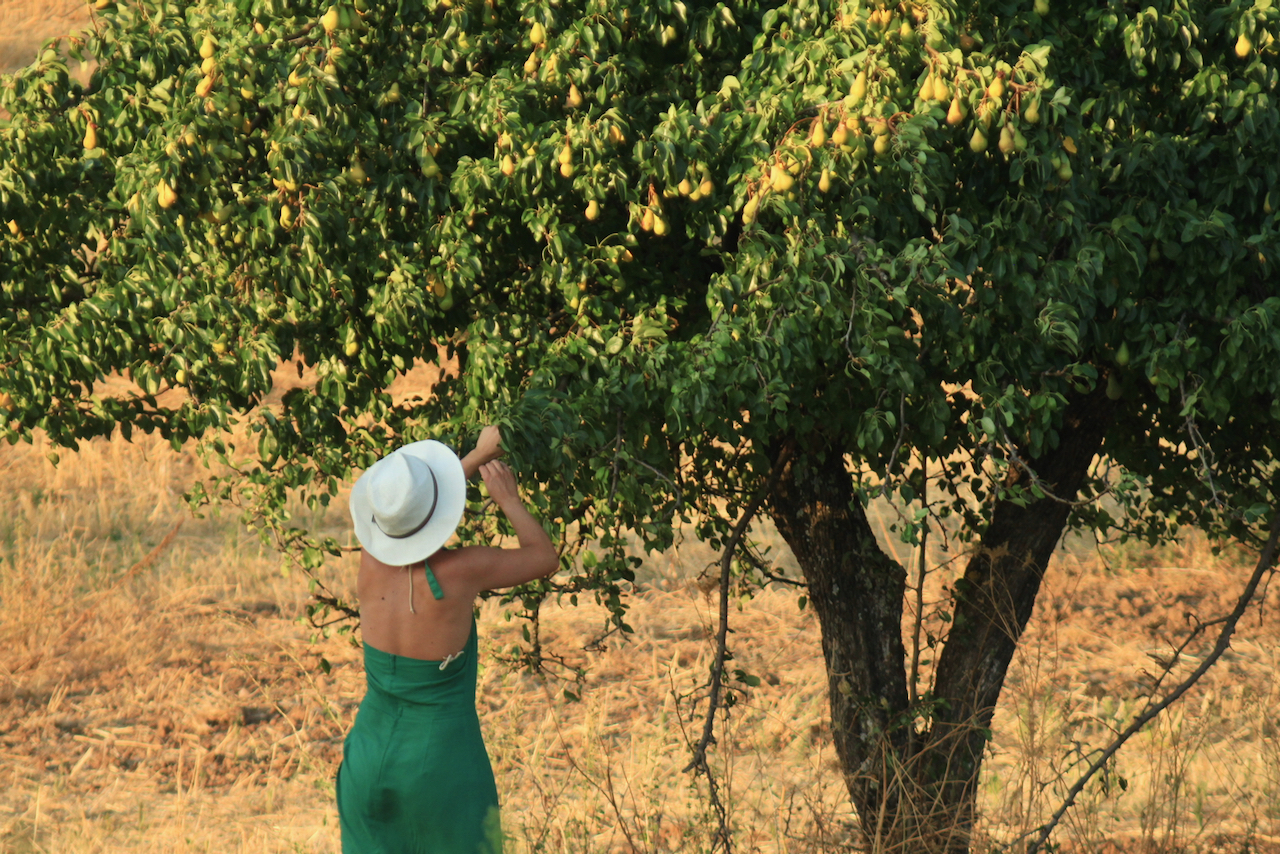
Silvia collecting fruits
Exploring the landscapes of the Algarve in the spring will reward you will picture perfect fields of blossoming almond trees, so important to make all the sweets above, and which make us think about how there’s really not that much distance (geographically and culturally) between the Algarve and north Africa. Orange trees are also common, and yet another reminder of the Moorish influence in the south of Portugal – did you know that orange fruit in Arabic is called burtuqal, from Portugal?
Another ingredient which thrives in the Algarve is alfarroba, or carob, which has in recent years been praised as a superfood, but that in the Algarve has been a part of the regular diet for many centuries. The carob pods are dried and turned into flour, which is used to make tarte de alfarroba, a carob pie which is reminiscent of cacao flavor and looks wise.
Algarve regional desserts
Eating around in the Algarve you’ll literally be able to taste the influence of the different civilizations that have settled in the south of Portugal over the centuries. If with salted tuna above we’re taken back at least 2500 years, we can travel to the 7th century and satisfy our sweet tooth thanks to Moorish influences. The Arabs from northern Africa introduced to Portugal ingredients which have shaped the region’s confections. We’re talking about citrus, honey, dried fruits and nuts, which are the backbone of the Algarve’s most typical sweets. These include marzipan shaped as colorful fruits or tiny animals (referred to in Portuguese as doces finos do Algarve); queijo de figo (also known as queijo de Maio, a dark layered block of flattened dry figs and flattened almonds); Dom Rodrigos (sugary egg threads and egg jam wrapped in colorful papers which look like little presents – which may or may not also contain shaved almonds); morgado (sugar and almond meal baked dessert, morgado de figo also contains dry figs, while morgado de amêndoa features a filling of sugary egg threads and figleaf gourd jam); figos cheios from Olhão (figs stuffed with ground almonds, flavored with fennel, chocolate, cinnamon and lemon – the Algarve’s answer to an energy ball!); or bolo de mel (also known as bolo de massa de pão and believed to have influenced bolo da Madeira, featuring a dense cake batter flavored with honey, Port wine, coffee, olive oil and spices).
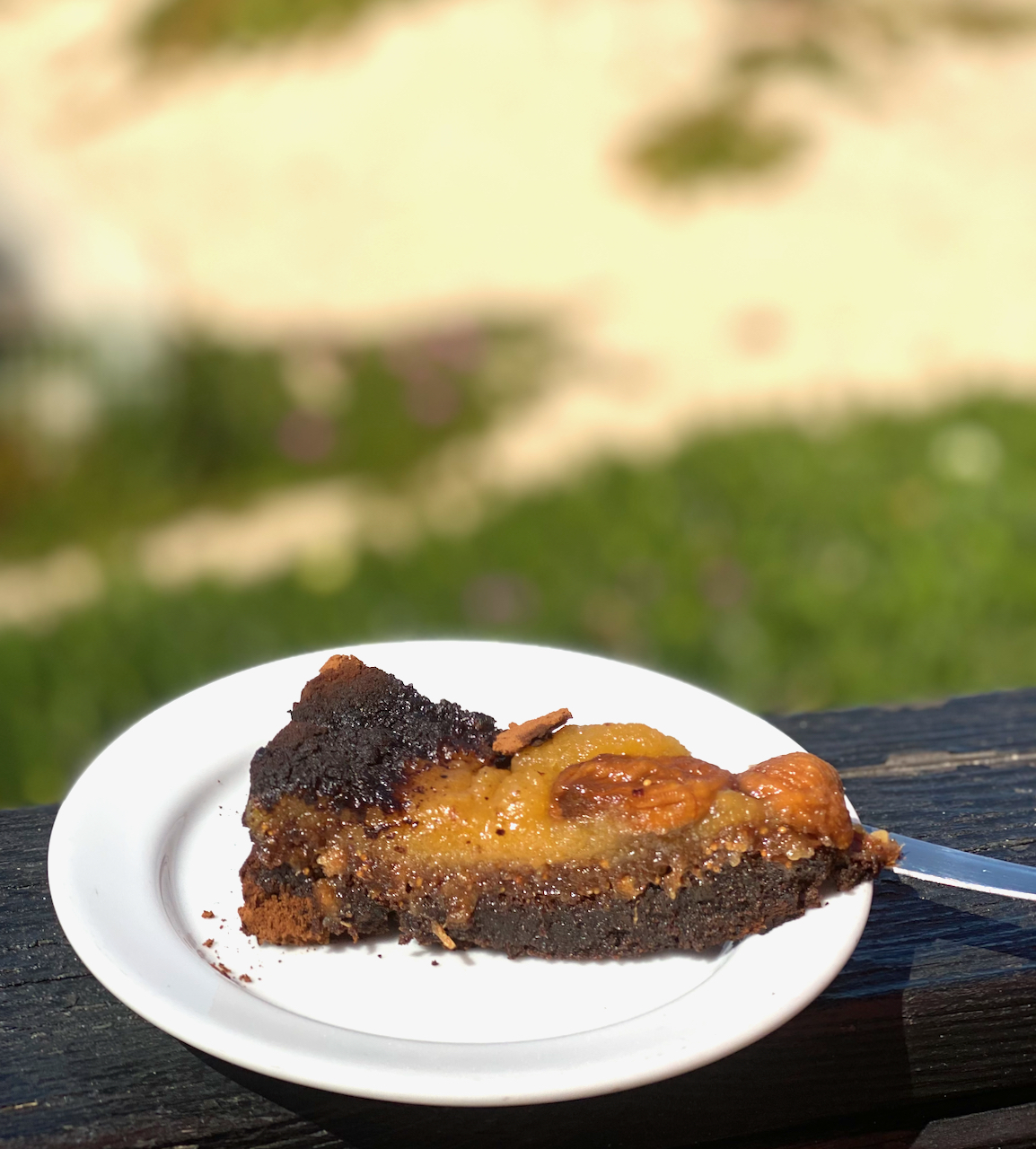
This ‘Três Delícias’ was served in front of a tiny and calm secret beach-village, located in the Alentejo coastline.
If there is one sweet dish that speaks of the influence that the Moors had, that is três delícias do Algarve, which translates as three delicacies from the Algarve, referring to almonds, figs and carob. This tart features a base of crumbled biscuits with almonds and dried figs, and a buttery filling with more almonds, sweet figleaf gourd and carob, boosted with cinnamon and a few other ingredients. Quite possibly, the dessert which better embodies Algarve’s favorite sweet ingredients!
Dried fruits and nuts aside, farófias, known in full as farófias de Loulé, are also one of the Algarve’s most typical desserts, and consists of poached meringues topped with custard. The recipe is believed to have originated in the convent of Nossa Senhora da Conceição, in Loulé, where the dessert was originally called nuvens, or clouds, because of its fluffy appearance.
To end your meal Algarve style but with fresh fruit instead of a sweet, ask for laranja azeitada, that is, slices of local Algarve oranges with a subtle touch of olive oil. This ultra simple dish can also be eaten as a snack, and it was historically so for many humble families, which besides olive oil would enhance the citrus with coarse salt and garlic. It may sound odd, but don’t knock it until you try it, especially as it may also come as a side dish if you order an Algarve style roast dish, such as those featuring lamb or pork.
Algarvian wine and medronho
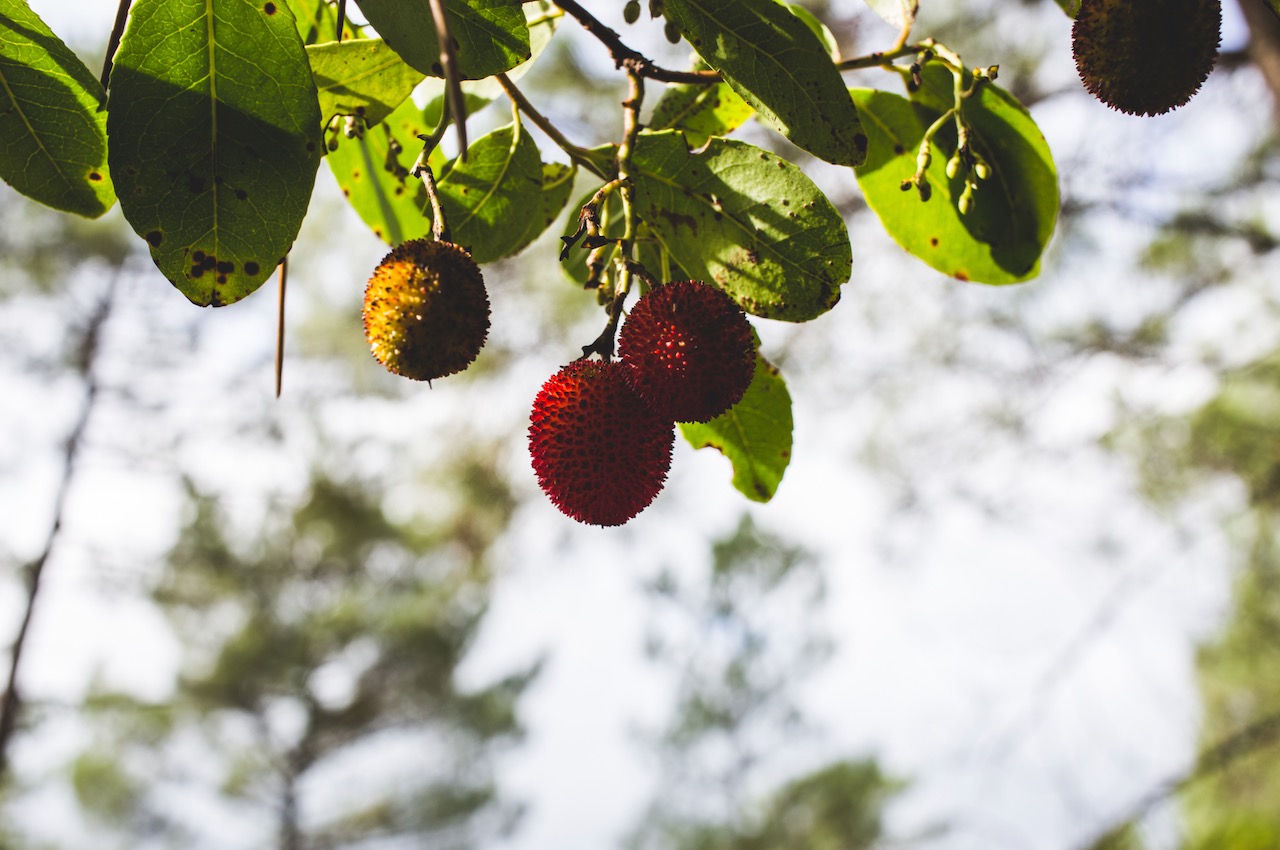
‘Medronho’ fruits
The Algarve wine region is classified as a Vinho Regional (VR) and it is one of the lesser known wine regions of Portugal. The majority of wines produced in the Algarve are reds, using international grape varieties like Syrah, but also Portuguese grapes such as Touriga Nacional and Castelão. As a small wine region in the making, the Algarve mostly hosts up-scale and independent wineries that face harsh climate conditions which tend to accelerate the maturation of grapes and so that many would consider not to be ideal for winemaking, as acidity tends to lack in the end product. Considering all of this, and precisely because of its uniqueness, we would highly recommend looking for some Algarve wines while in the region – whether you like them or not, trying them is certainly a worthwhile experience!
Wines aside, the Algarve is home to other traditional alcoholic drinks which you can sip as an aperitif or digestif after your meal. The most popular ones include licor de amêndoa amarga (an amaretto reminiscing liquor made with almonds, which also goes by the name amarguinha, and which tastes deliciously on the rocks with a little squeeze of lemon), aguardente de medronho (brandy infused with the fruit from the strawberry tree – not to be mistaken with actual strawberries – also known as licor de medronho), and licor de figo (fig liqueur). In case you can’t visit Algarve, try one of the best Algarvian medronho, from a local producer available at Medrosa d’Alfama (Largo de São Rafael 6, 1100-559 Lisboa).
From north to south, Portugal looks forward to welcoming the hungrier side of you!
Itinerary overview for a food trip in the Southern provinces of Portugal
Most characteristic places you should visit:

There are several refreshing rivers and dams in the Alentejo Interior when traveling during summer!
Marvão
- Elvas
- Évora
- Reguengos de Monsaraz
- Beja
- SouthWest Alentejo and Vicentine Coast Natural Park
- Sagres
- Lagos
- Alvor
- Silves
- Loulé
- Faro
- Ria Formosa Natural Park
- Olhão
- Tavira
Must-eat traditional dishes:
- Pão Alentejano
- Sopa de cação
- Açorda Alentejana with salted cod
- Iberian black pork (grilled and as charcuterie)
- Carne de porco à Alentejana
- Sericaia with preserved plums from Elvas
- Pão de rala
- Encharcada
- Oysters from Ria Formosa
- Cataplana de mariscos
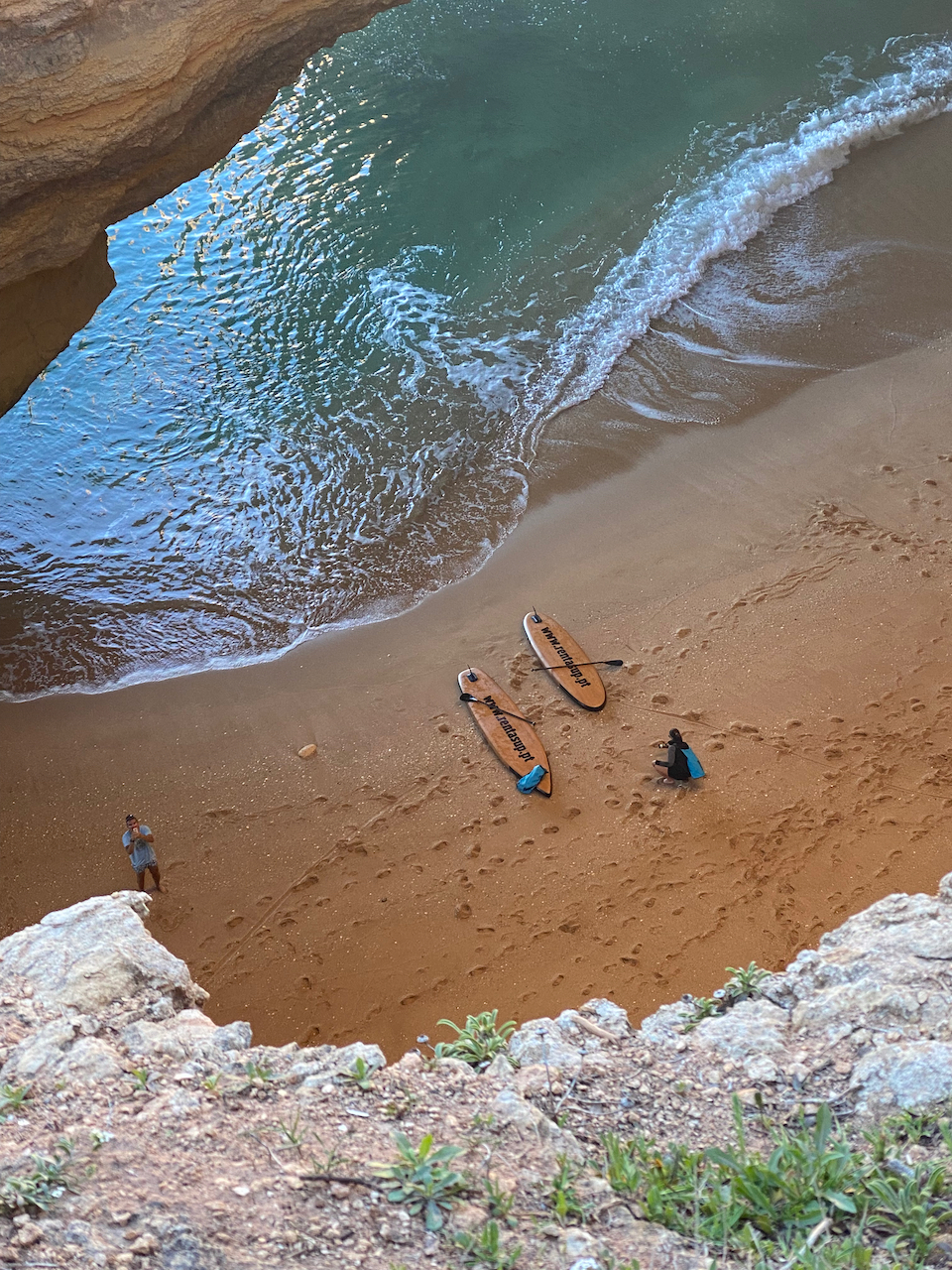
Photo taken along the emblematic Algarvian trail “Seven hanging valleys”
Xerém com conquilhas
- Lulas à Algarvia
- Farófias
- Dom Rodrigo
- Morgado
Typical drinks to try:
- Regional wines from the Alentejo and the Algarve
- Vinhos da talha
- Aguardente de medronho
- Licor de amêndoa amarga
Off-the beaten path culinary treasures:
- Visit the Alentejo during March and April and try to look for túberas – approach locals around places like Mértola or the Serra de São Mamede Natural Park, and ask them how to identify the “white Portuguese truffle”, forage it, and scramble it with eggs as per the local customs;
- Have a meal at Estaminé, the one and only restaurant at Praia da Ilha da Barreta, aka “Algarve’s deserted island” – you can only get there by boat, which takes about 20 minutes from Faro, and which runs exclusively between June and September;
- Many would argue that the world of Portuguese cuisine (from the door out) is male dominated, but you can visit Noélia in Cabanas de Tavira (Algarve) and trust Chef Noélia Jerónimo to make you feel otherwise at her homonymous restaurant!
- We can’t call Adega Vila Lisa a restaurant. This is an Algarvian home, in Mexilhoeira Village. The feeling is that you have been invited by local friends to have a multi-course meal or, if you prefer, by locals who share with you your passion for food, local ingredients, local history, and people. Vila and Lisa, are the surnames of the two men who started to cook local meals in this place, in 1981.
- Walk the impressive trail “Seven hanging valleys” but follow our suggestion in order to avoid the crowds and the high temperatures.

Alentejo landscape near Vimioso village
Article by :
Zara Quiroga (freelance food writer and food & cultural leader at Oh! My Cod Pico Trips)
Sílvia Olivença (anthropologist and food guide/CEO at Oh! My Cod Ethnographic Food Tours & Trips)
Photos by:
Sílvia Olivença (anthropologist and food guide/CEO at Oh! My Cod Ethnographic Food Tours & Trips)
Want to more about Portuguese cuisine?
Pico Wine: one of the world’s most unique wine regions (Genesis – Part I)
